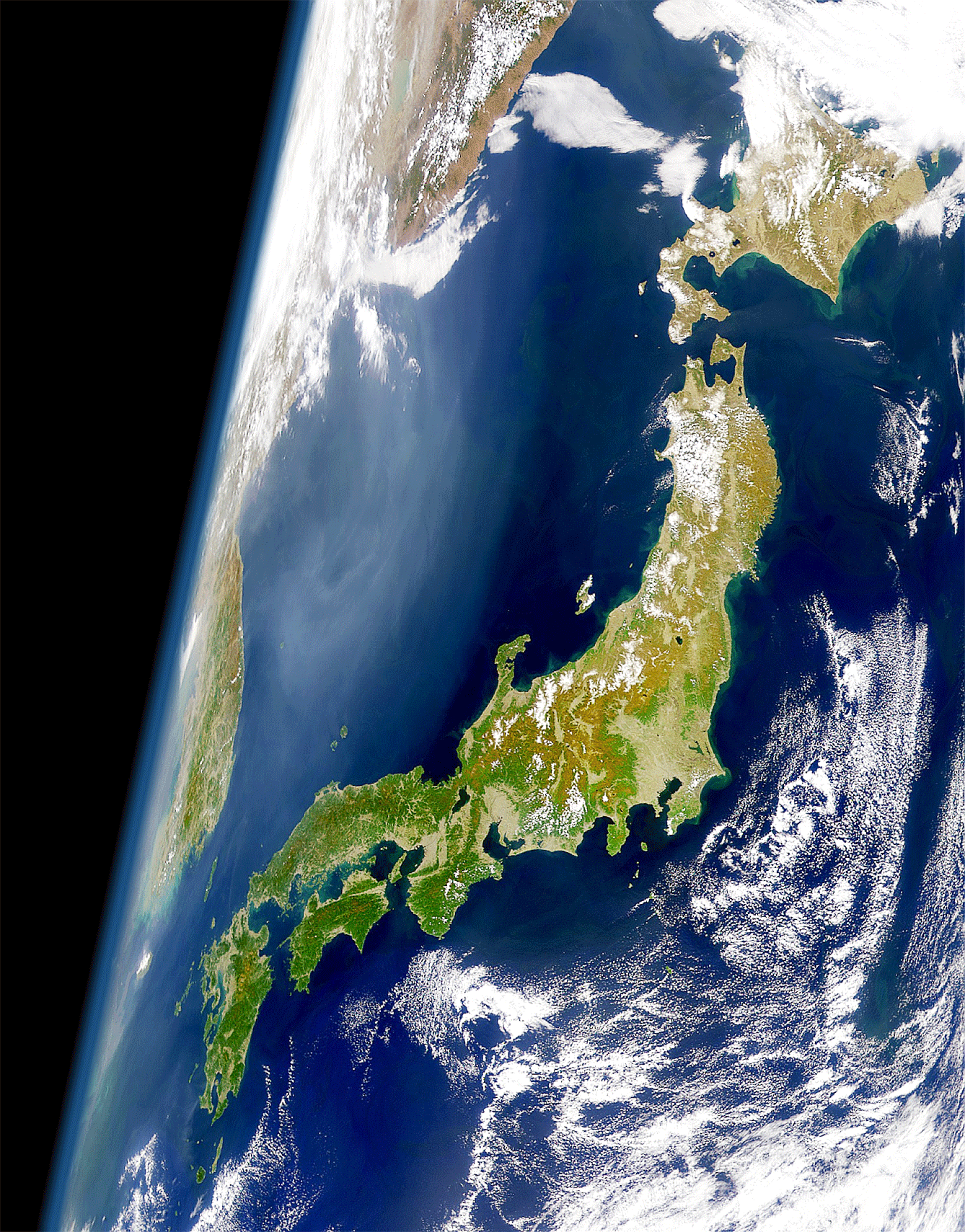 |
READING HALL |
 |
JAPAN'S GENERAL HISTORYLIBRARY
JAMES MURDOCH'HISTORY OF JAPAN FROM THE ORIGINSTO THEARRIVAL OF THE PORTUGUESE IN 1542 ADCHAPTER I. PROTOHISTORIC JAPAN (CHINESE AND
KOREAN SOURCES.)
CHAPTER II. LEGENDARY JAPAN. (JAPANESE SOURCES.)CHAPTER III. OLD YAMATO (400 A.D. - 550 A.D.)
CHAPTER IV. OLD YAMATO.FROM THE INTRODUCTION OF BUDDHISM TO THE GREAT COUP D’ETAT (550 TO 645 A.D.)
CHAPTER V. THE GREAT REFORM OF 645.CHAPTER VI. FROM TENCHI TO KWAMMU. (662 TO 782 A.D.)CHAPTER VII. THE EMPEROR KWAMMU. (782 TO 805 A.D.)CHAPTER VIII. THE LEARNED EMPERORS. (806 TO 850 A.D.)CHAPTER IX. THE GREAT HOUSE OF FUJIWARA.CHAPTER X. THE CLOISTERED EMPERORS.CHAPTER XI.
|
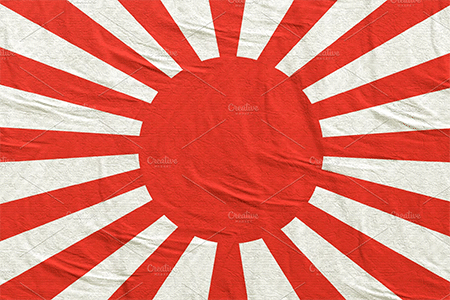 |
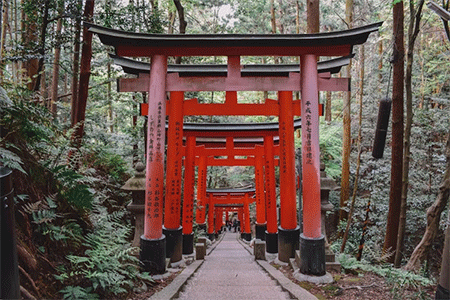 |
SHINTOTHE ANCIENT RELIGION OF JAPAN |
-------------------------------------------------------------------------------------------------------------------
...................................................
OUR information concerning the earliest inhabitants of
Japan is alike scanty and unreliable. At different spots in Yezo and the Kurile Islands excavations are found from three to six feet deep, with
a length or diameter of fifteen to twenty feet; these he in groups, numbering
as many as one thousand, and are attributed by the Ainos to a people called Koro-pok-guru, meaning
"people having excavations", or "cave-dwellers", or to the
Ko-bito (dwarfs), who are said to have inhabited the island before the Ainos and to have been exterminated by them. These holes
were probably covered with a roofing of branches on which earth was laid.
Excavations in their neighbourhood have brought to
light potsherds and stone arrows, a fact which is the more remarkable, as the
Aino seem never to have learnt the art of making pottery, which they do not
even now possess. On the other hand, a few centuries ago they made use of stone
arrowheads; these were later replaced by points of bamboo, which are both more
easily made and better suited to hold the poison which they employ in hunting.
Nothing is known as to the origin of the Koro-pok-guru or of the Ainos;
apparently both peoples immigrated from the north at an early period; the Ainos at any rate advanced as far as the northern half of
Hondo, and perhaps even farther south. Some authorities consider the Ainos a Mongolian, others a Polynesian, people. Dr. E. Baelz places them among the Caucasian races, and believes
them to have been related to the Mujiks, the peasants of Great Russia; the
resemblance, at any rate in advanced years, is certainly remarkable. In this
case we must consider the Ainos as members of a
greater continental race, which migrated to Japan in prehistoric times and was
gradually driven further northward by later arrivals, ultimately crossing into Yezo by the Tsugaru Strait. There are probably twenty
thousand of them in Yezo, the southern part of
Sakhalin, and in the Kurile Islands. Where their race has maintained its
purity, their civilization is scarcely higher than it was at the time when they
first came in contact with the Japanese.
The origin of the Japanese is also wrapped in mystery.
The attempt to solve the problem from the anthropological side, and to consider
the modern Japanese as a mixed people consisting of Ainos,
Korean, Chinese, and Malayo-Chinese elements may be
said to have been successful, in so far as all these races have undoubtedly
contributed to the formation of the nationality now inhabiting Japan; but no
proof has been brought forward to show to which of these races the main body of
those immigrants belonged, who probably made their way into Japan long before
the seventh century B.C.
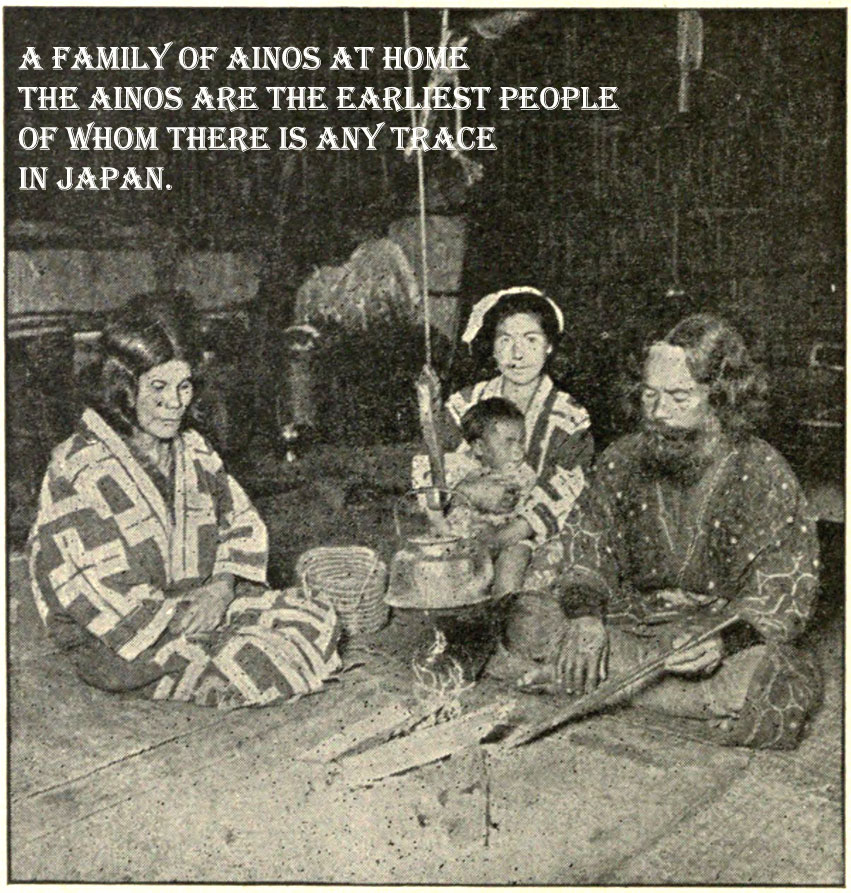 |
Ethnological comparisons promise better results. The
practice of soothsaying by means of the shoulder-blade of a slaughtered animal,
and that of sending horses and servants to accompany a dead prince, who were
not killed and buried with him, but were partly buried in an upright posture
round the grave mound to serve as a living fence—these seem to have been
Japanese customs from a very early antiquity. For purposes of soothsaying they
used the shoulder-blades of the stag; the sheep, which is usually employed for
this purpose in Northern Asia, is not found in Japan.
Concerning their burial customs, the chronicle known
as the Nihongi speaks as follows : “The brother of the Emperor Suinin [29 BC- 70 AD] died and was buried at Musa. All
those who had been in his personal service were gathered together and were
buried alive in an upright position around his barrow. They did not die for
many days, but wept and bewailed day and night. At length they died and became
putrid. Dogs and crows came together and ate them up”. The emperor, who had
listened to the lamentations, ordered the abolition of this custom; and it is
said that from the year 3 A.D. clay figures instead of human beings were buried
in or about the barrows. Pieces of these figures are constantly found at the
present day. However, this ordinance was frequently disregarded. Thus the
Chinese annals of the Wei dynasty stated that, on the death of the Empress
Regent Himeko (Jingo Kogo,
according to the Japanese lists), in the year 247 A.D., a large mound was piled
above her grave, and more than a thousand of her male and female servants
followed her in death.
It is indeed difficult to eradicate customs which have
become part and parcel of the national life, as is the case when the unwilling
sacrifice has become voluntary in the course of centuries and is considered an honourable duty. In the year 646 AD the Mikado issued an
order for the cessation of all these customs—namely, suicide or the murder of
others for the purpose of sharing the fate of the deceased, the killing of his
horses, the burying of treasure for the benefit of the dead, the cutting short
the hair, stabbing in the thigh, or loud wailing on the part of mourners; yet
almost a thousand years later we find Iyeyasu obliged to forbid the Samurai to
kill or mutilate themselves upon their master's grave. Both of these customs,
divination by shoulder-bones and the slaughter of servants at their master's
grave, are undoubtedly of North Asiatic or Tartar origin. They also existed in
China. Confucius mentions the second of these customs as belonging to
antiquity, as also the substitution of wooden figures for human sacrifices; and
the last known example occurs in the time of the present Manchu dynasty after Kanghsi's ascent of the throne (1662). They are to be
retraced to the influence of Tartar dynasties. Moreover, the obscene character,
of a part of the Shinto mythology and the popular phallic worship, which was practised without concealment in Japan so recently as 1860,
and existed in 1907, less openly, are evidences in favour of a Tartar-Shamanist origin. Finally, it is important to observe that the
earliest events of importance in Shinto mythology are laid not in Kyushu, which
would be evidence in favour of an immigration from
the west or south, but in Izumo, Yamato, and Setsu, thus pointing to a
migration from the north. According to Chinese annalists,
Korea was conquered and civilised by a member of
their Shan dynasty, Kit-sze, on the fall of that
dynasty, 1122 B.C.; therefore the migration from Korea to Japan must have taken
place before that date, as the immigrants in question had certainly never come
in contact with Chinese civilisation. It is, however,
quite possible that this migration may have started from one of the Manchurian
states (for example Funu) lying to the north of
Korea. According to Chinese sources of information the inhabitants of these
districts seem to have had many ideas and customs corresponding to those of Old
Japan. In that case, old Engelbert Kampfer was correct when he wrote in 1712 : "Strangers
from Datz, or Tartary, have long lain concealed in
Japan under a name of doubtful meaning, and, scattered about the provinces,
lived the wild life of fish-eaters."
|
|
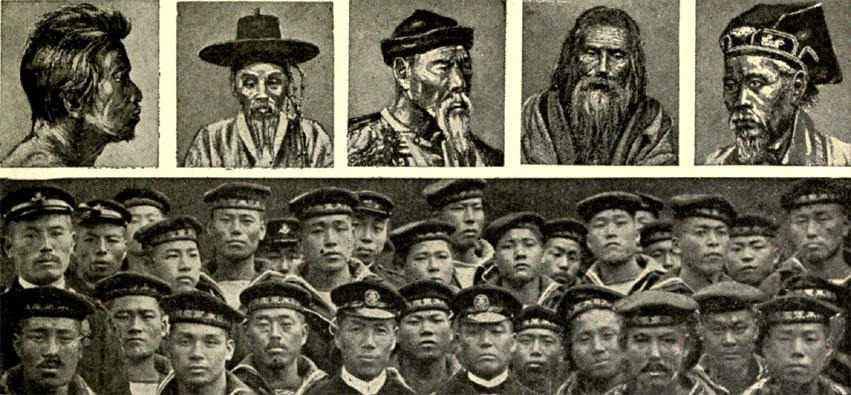 |
It is hardly within our scope to detail, and it would
be unprofitable to summarise, the extravagances of
the Japanese accounts of the cosmogony, the evolution of the world out of
chaos, the union of one of the sons of the gods with the daughter of the first
man and woman, the immigration, so to speak, of gods and the rule of demigods
on the earth.
Myth may be regarded as beginning to merge in
historical fact with the rule of the last lord of divine birth, Kami-Yamato-Iwaré-Biko, the youngest son of the last terrestrial spirit
and the daughter of the dragon-god Riyo-siu, whom
Japanese expositors regard as a ruler of the Loo-choo Islands. In the year 667
B.C., at the age of forty-five, he advances with his three brothers to conquer
the whole kingdom of Japan. He first subdues Tsukushi (the modern Chikuzen and Chikugo),
then Kibi (that is, the provinces of Bizen, Bitchu, and Bingo) in Kyushu, and also Aki in Hondo. After
three years of preparation for a further campaign he sails along the coast with
his fleet to Naniwa (Osaka), where he lands. However, at Kusagesaka in Yamato and at Kumano, in the province of Kii, he
is beaten, and is obliged to retire to his fleet. He loses the greater part of
his ships in a storm; the remainder are saved only by the devotion of two of
his brothers, who cast themselves into the sea to appease the anger of the
gods. With fresh troops he returns to Yamato, and in the year 660 B.C. subdues
the independent petty chiefs, partly by treachery, his supremacy being
established by the surrender of the tokens of empire—the sword, mirror, and
insignia, which had hitherto been in different hands. He builds his residence,
half palace and half temple (that is, house for ancestors) on the mountain Uji
in Yamato, and hands over the government of the kingdom to four Ministers, one
of whom becomes the ancestor of the famous family of the Fujiwara. The first
"heavenly king" of Japan is known by the name of Jimmu,
Spirit of War, which was given him after his death; so run the Japanese
narratives.
If there be any substratum of reality in these
traditions, it probably consists in the fact that the main settlement of the
immigrants was situated in the provinces of Izumi, Yamato and Setsu, which were
united at a later period with Yamashiro and Kawachi,
and formed the Gokinai (the five original provinces),
which was the central part of the kingdom. From this centre the advance to the conquest of the western and southern districts was made. Jimmu's expedition was probably undertaken to enforce the
recognition of actual or putative rights which had existed at an earlier
period; he is said to have married the daughter of the ruler of Izumi. The
struggles appear to have been fought out between members of the same clan.
Whether the Takeru, who are mentioned later as
inhabiting Kyushu, are to be identified with the Kumaso,
whether they were members of the immigrant hosts, whether and how far they were
commingled with the Malay-Chinese or Korean nationalities, are problems
insoluble at the moment.
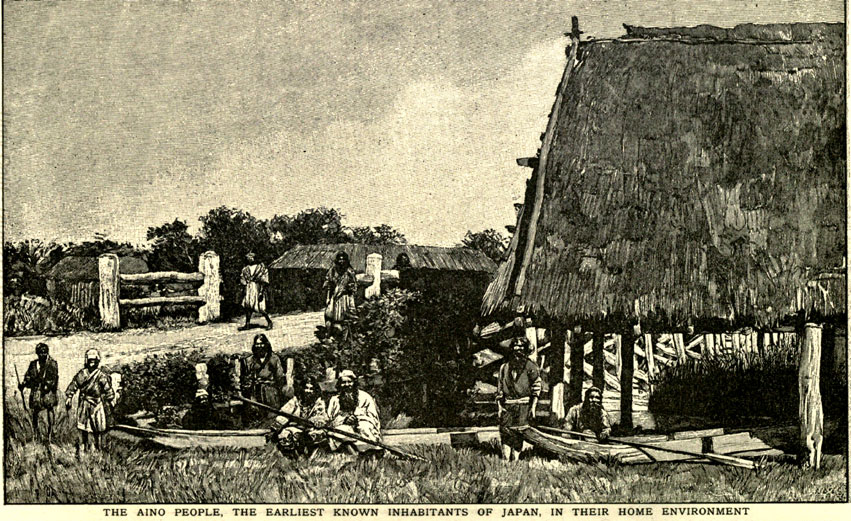 |
According to Japanese sources of information the first
Korean immigration is said to have taken place in 59 A.D.; however, embassies
from Korea seem to have arrived in the country as early as 33 B.C. In the north-east
the Ainos were the only enemies with whom the
immigrants had to contend, although their opponents in that direction are
mentioned under different names.
|
|
 |
The great obstacle to the proper comprehension and
narration of early Japanese history is the fact that native historical records
are entirely wanting until the eighth century A.D. Until the sixth century A.D.
the Japanese possessed no syste of writing of any kind, and from that period
until the invention of the Katakana syllabic script in the ninth century they
used nothing but the Chinese characters.
The oldest piece of historical writing extant, the Kojiki, the "book of old traditions," was
completed in the years 711 and 712; two older works, apparently time between
the years 620 and 681, have been lost. The Kojiki contains the history of the creation, of the gods and heroes, and of the Mikados, up to the year 628 A.D.; it was printed for the
first time between 1624 and 1642. The next work in point of age, the Nihongi,
"Chronicles of Japan," belongs to the year 720 A.D., and treats of
the same subject-matter as the Kojiki, except that it
carries the annals of the emperors to 699.
For this reason, apart from the fact that Chinese,
Korean, Buddhist, and Confucian influences are very strongly marked, these
books can only be used with the utmost caution. The lists of rulers given by
them often fail to correspond with those contained in Chinese works upon the
subject—for example, that of Matuanlin. Moreover,
they obviously bear the stamp of improbability. For instance, they relate that Jimmu reached the age of 127 years, and that among his
first sixteen successors, the last of whom died 399 A.D., thirteen lived more
than 100 years; one of them, Suinin, the Solon of
Japanese history, lived 141 years, and ruled for 99 of them! Moreover, the long
line of tne Mikados—the
late Mikado, Mutsuhito, was the one hundred and twenty-third—does not continue
in direct succession according to our ideas, but as even Japanese accounts
admit, is broken by seven empresses and many adopted children.
Where contemporary Chinese and Korean accounts exist
side by side— and this is constantly the case in the histories of the individual
dynasties and states of these countries—the Japanese versions usually appear
wholly untrustworthy. For instance, as regards the Empress Jingo Kogo (201-269) and her reported successful conquest in 202
of Shiraki in Korea, the account given by the writer
of the Nihongi is adorned with impossible extravagances.
Apart from all the evidence against any historical
foundation to the narrative (such as the mention of names which can be proved
not to have existed at that period), the Chinese and Korean annalists mention
Japanese attacks against Silla only in the years 209, 233 and 249. The first
was a wholly unimportant event, while in the two latter the Japanese were
defeated with heavy losses in ships and troops. The annals of the Chinese Wei
dynasty of the year 247 mention the death of the Queen Himeko—that
is, Jingo Kogo—and relate that, after the outbreak of
a civil war in which 100,000 persons were killed, a girl of thirteen years of
age succeeded to the throne. This is a far more probable account than the story
that Jingo Kogo reigned 68 years after her consort's
death.
Influenced by these and similar discrepancies between
the Chinese and Korean historians on the one hand and the Japanese upon the
other, W. G. Aston has declared his conviction that the Japanese narratives are
unworthy of credence, not only up to 400 and 500 A.D., but also during the
sixth century of our era. He considers that the first demonstrably historical
event in Japanese chronology occurs in the year 461 A.D. Japanese history properly
so called does not begin before 500 A.D., and the introduction of Chinese civilisation into Japan took place 120 years later than the
date given by the Japanese to that event—in 397 A.D., instead of 277 A.D.
Modern Japanese criticism has also declared against
the credibility of the Nihongi. In 1889, Tachibana Riohei collected a large number of instances showing the unreliable character of the
work. According to the Nihongi, Yamato Daké, the
national hero of the Japanese, died in the forty-third year of the Emperor
Keiko—that is, 114 AD—but his son Tsinai, according
to the same authority, was born in the nineteenth year of the reign of Seimu (150)—that is, thirty-six years after his father's
death. Prince Oho-usu-no-mikoto was the twin-brother of Yamato Daké; the latter was
aged sixteen when he took the held against the Kumaso in 98 AD, so that the brothers must have been born in 83 AD. But the Nihongi
informs us that Prince Oho ill-treated a nobleman's daughter in the year
75—that is, eight years before his birth. A large number of similar
discrepancies have been collected.
Consequently, to reconstruct Japanese history from the
foundation of the empire (660 BC) to the introduction of Buddhism, we are
forced to restrict ourselves to such information as can be checked and
corrected by accounts other than Japanese. These latter are, at best, nothing
but a patchwork of incredible traditions arbitrarily put together, apparently
with the object of providing some support for the claims which the ruling
dynasty advanced at a later period. Hence there can be no possible doubt that
the three original settlements of the immigrants, Yamato, Izumi, and Tsu-kushi (Northern Kyushu), existed independently of one
another long after the time of Jimmu. In the annals
of the Han dynasty of China (25-220 AD) mention is made of Japanese embassies
which could only have been sent out by petty princes. The Chinese records
compiled by Matuanlin in the thirteenth century show
how low was the stage of Japanese development at the time when these accounts
were written.
The annals of the later Han, referring to Japan, say
that there was a mountainous island to the south-east of Korea, divided into
more than a hundred districts. After the conquest of Korea by Wuti (140-86 BC) thirty-two of these tribes, who called
their hereditary rulers kings, are said to have entered into communication by
messenger with the authorities of the Han. The ruler of "Great Wo"
(Japan) resided in Yamato, and the customs of the people were similar to those
of the Chinese province of Chekiang (600 miles away), which lay opposite to Wo.
The soil was suitable for the cultivation of com, hemp, and mulberry trees. The
people understood the art of weaving. The country produced white pearls and
green nephrite. In the mountains there was cinnabar. The climate was mild, and
vegetables could be cultivated both in winter and summer. They had no oxen,
horses, tigers, leopards, or magpies. Their soldiers carried spears and
shields, bows and arrows of wood, the points in many cases being made of bone.
The men tattooed their faces and bodies with designs. Difference of rank was
denoted by the size and position of these designs.
The clothes of the men were fastened crossways by
knots, and consisted of one piece of material. The women bound up their hair in
a knot, and their dress resembled Chinese clothes of the thickness of one
piece; these they drew over their heads. They used red and purple colours to besmear their bodies as the Chinese used
rice-powder. They had forts and houses protected with palisading. The father
and mother, and the elder and younger brothers of a family, lived apart, but
when they came together no difference was made between the sexes. They took up
their food in their hands, but laid it upon plates of bamboo and wooden dishes.
They all went barefoot. Reverence was paid by crouching low. They were very
fond of strong drink. They were a long-lived race, and people a hundred years
old were constantly met with. The women were more numerous than the men. All
men of high rank had four or five wives, others two or three. The wives were
faithful and not jealous. Theft was unknown and litigation extremely rare.
The wives and children of criminals were confiscated,
and for grave offences the criminal's family were destroyed. Mourning lasted
only ten days; during that period the members of the family wept and lamented,
while their friends came, sang, danced, and made music. They practised soothsaying by burning bones over the fire, and
thereby predetermining good or evil fortune. They appointed one man who was
known as the public mourner; he was not allowed to comb his hair, to wash, to
eat meat, or to approach any woman. If they, the survivors, were prosperous,
they made him valuable presents; but if misfortune came upon them, they blamed
the "mourner" for having broken his vows, and all joined in killing
him, a custom the existence of which is confirmed by Japanese sources.
Further on we are told that between 147 and 190, Wo
was in a state of great confusion, and civil wars continued for many years,
during which period there was no ruler. Then a woman, Pimihu (Himeko), appeared. She was old and unmarried, and
had devoted herself to the arts of magic, so that she was able to deceive the
people. The people agreed to recognise her as queen.
She had 1,000 male servants; but few saw her face, except one man, who brought
her meals and maintained communication with her. She lived in a palace of airy
rooms, which was surrounded by a palisade and protected by a guard of soldiers.
From the third century A.D. we have constant
references to embassies from Japan to China bringing presents (tribute) and
seeking grants of titles and seals. Many of such mentions may have been
inspired by Chinese vanity alone; none the less, it is quite possible that the halfbarbarian Japanese of that age may have been flattered
by the conferment of such outward distinctions, although their descendants
naturally deny the dependency of their country upon China. Traces of a certain
degree of dependency are to be found until the period of the great Mongol
invasion of 1370-1380.
From the last century B.C. closer and more constant
connections subsisted between Japan and the states in the south of the Korean
peninsula. It is not easy to distinguish the character or results of the
various embassies, incursions, and larger expeditions undertaken by the State
or by individuals; at any rate, many of the hostile descents of the Japanese
upon the Korean seaboard of which we hear were made as often for piratical purposes
as to support one or other of the political parties in Korea.
|
THE CEREMONY OF WORSHIPPING THE IMPERIAL ANCESTORS IN
JAPAN The worship of their common ancestor was the bond of union within each
tribe in Old Japan. Each tribe, with its chief, formed a self-contained whole,
the Emperor's tribe being the most numerous and powerful. The Imperial
ancestors were worshipped by the tribe as a whole, the custom being attributed
to Confucian influences.
|
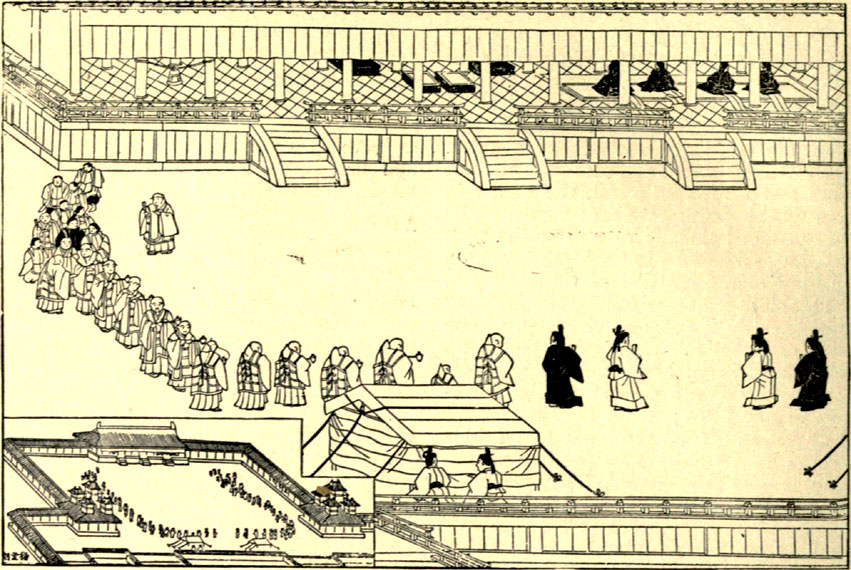 |
The Japanese State was too loosely organised at that period to have provided the impulse to each one of these different
movements. E. H. Parker, who has made a special study of the relations of
China and Japan with Korea, says on this point: "The Chinese twice overran
Korea, once in the third century B.C. and once in the seventh century A.D. In
both cases their personal government was of short duration, and their
viceroyalty never extended over the northern half, and for some time not even
beyond the mountain range which divides the northern half into eastern and
western portions. The Japanese never set foot in that part of Korea which was
actually under Chinese influence, except during a few months in the time of Hideyoshi at the end of the sixteenth century. They never
really subdued any part of Korea. It is, however, possible that scattered
remnants of the Japanese race may have existed in the extreme south of the
peninsula during the first century A.D. There is no doubt that Japanese
influence was strong in the south-western parts until the second Chinese
invasion. At a later time they were mere pirates, until Hideyoshi conceived the idea of attacking China by way of Korea. On the other hand, the
Japanese from the earliest to the latest periods seemed to have possessed a
settlement in the extreme south of Wars with Korea, or at Fusan". Japanese
records mention many battles with the Kumaso in
Kyushu, who were either invaded and attacked in their own country, or
themselves invaded and overran the western provinces of the main island. The
first battles against these eastern neighbours are
those mentioned as having occurred under the Emperor Keiko (71-130 AD). His
son Yamato Daké, the warrior prince, carried the tame
of the Japanese arms, though certainly only for a time, into the mountain
district of Nikko, north of the modern capital, Tokio.
In other respects, the records are confined to accounts of the gradual and very
slow development of the interior, which is naturally ascribed to the enterprise
of emperors. Sujin, the tenth emperor (97-30 BC),
is saig to have constructed the first aqueduct for
the irrigation of rice fields. His successor, Suinin (29 B.C.-70 AD), continued the work, and extended it by making canals; he is
also said to have encouraged the national god worship. He seems also to have
been the first to introduce a system of taxation, a reform of which the chief
object was to provide funds for religious worship. Under the twelfth Mikado, Seimu (131-190), an expedition against the Aino of the East
took place, and under the fifteenth, the Empress Jingo Kogo (201-269), occurred the fabulous voyage to Korea. Her son Ojin,
of whom she is said to have been pregnant at the time, and who for that reason
has since been worshipped as the god of war (Hachiman) succeeded her (270-310),
and is reported to have paid special attention to trade and manufactures,
teachers of which he brought over from Korea. His successors imitated his
example, and thus we reach the epoch of the introduction, through Korea, of
Chinese civilisation into Japan, although many of the
statements upon this subject must be considerably post-dated.
During the whole of this period the immigrants seem to
have been in no very close relations with the Emperor. Fukuda Tokuzo connects these "Yamato" even during their
earliest period by the fusion of three subordinate tribes—the "descendants
of heaven" (Tenson), the "heavenly deities" (Tenjin), and the
earthly deities (Chiji) standing in different degrees
of relationship to the sun-goddess. But here he is probably describing the
results of later developments; such distinctions do not usually become manifest
until the necessity is apparent for sharper lines of demarcation between the
upper and lower grades of society, and this can hardly have been imperative at
the stage of development reached by the immigrants about 660 B.C.
The development of the priesthood must also have been
a very slow process even according to the Japanese reports. The more pronounced
ancestor-worship with which were connected the more definite distinctions of
social rank may be ascribed to later (Confucian) influences.
This much is certain, that the race which had the
upper hand in Central Japan—the power of the "Yamato" scarcely
reached beyond this region—was composed of a large number of tribes (Uji), each
of which had originated in a single family. Both in Japan and China we find the
same course of development which was followed in Greece, Rome, Germany, and
among the North American Indians. Such tribal unions increase to a remarkable
degree the stability and permanence of the body politic in which they pass the
first stages of their constitutional development. In Japan each tribe with its
chief formed a self-contained whole, the Emperor's tribe, under his personal
leadership, being the most numerous and powerful. The worship of their common
ancestor was the bond of union within each individual tribe, and the worship of
the sun-goddess formed the tie between the Imperial and the other tribes. The
creation of fresh tribes, especially of prisoners of war, slaves, and servants
or craftsmen attached to the Imperial Court, seems to have been a privilege of
the Emperor, who was thus able to increase the strength of his household
troops.
It seems that originally within the tribe, while it
was yet small, the products of hunting, fishing, and agriculture were held in
common, and that ultimately there was community of all acquisitions. The tribe
could also enter into external relations without losing its corporate
character, appearing in some respects as a legal personality. Certain offices
belonged to the tribe, and were hereditary in it: the man followed the woman
into her tribe, to which also the children belonged. The power of the head of
the tribe over the members was very considerable, but, on the other hand, the
relations of individual Uji to the Imperial tribe seem to have been very loose.
They consisted chiefly in the recognition of the Emperor as high-priest for the
worship of the common ancestral goddess, as warlord, as the representative of
the common interests abroad, and as chief judge to decide disputes between the
different tribes. The Emperor had no right over their land or property.
|
|
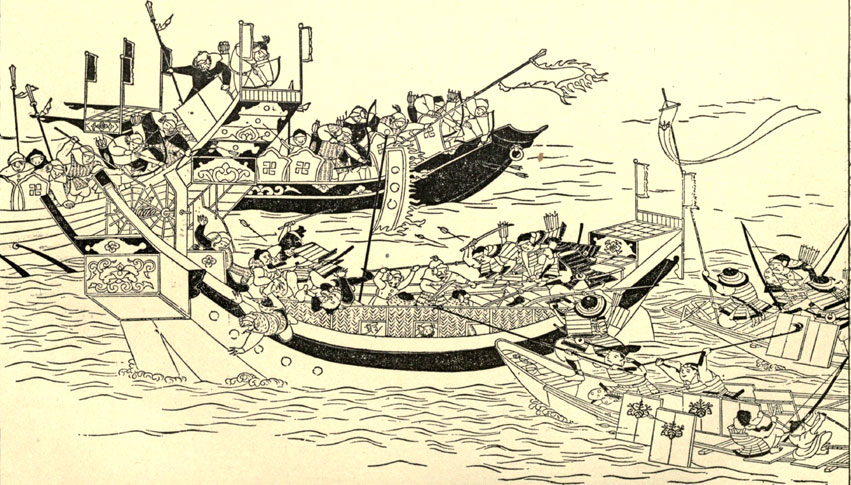 |
IF the Japanese annals are to be believed, Jimmu, immediately after the foundation of the empire,
handed over the government to four Ministers, one of whom was an ancestor of
the family of Fujiwara. In this piece of information we may probably recognise nothing more than a desire, formulated by this
powerful family some fifteen hundred years later, to justify their actual
predominance by reference to an antiquity as remote as possible.
In reality, the true state of affairs for a long
period must have been that the supreme chieftains of the victorious tribe found
themselves obliged to defend and to extend their tottering supremacy as best
they could. As the emperors attempted to strengthen the forces under their
control, so also did the chieftains of other tribes (Uji). Conflicts can be
shown to have been waged in the course of centuries between the emperor and
unruly Uji chiefs, which were generally decided by the interference of other
chiefs in favour of one or other of the contending
parties, and not always in favour of the rightful
superior. Such struggles constantly broke out over questions concerning the
succession to the throne, for it was not until the reign of Kwammu (782-806) that the right of primogeniture was asserted, and it was some time
before it advanced from the theoretical to the practical stage.
These continual contests for power and supremacy
involved the downfall of the old tribal system. The ultimate causes of the
change are to be found in the increase of the population and consequently of
the members of the individual tribes, and also in the increased necessity for labour to provide sustenance for individuals, resulting in
the abandonment of fishing and hunting for agriculture. The rise of the family
and of the individual within the tribe gradually made itself felt as a danger
both to the upper and to the lower strata of society : to the upper, because
the Uji system, in the event of a rapid increase in the members of the tribe,
placed these numbers at the immediate disposal of a vassal anxious to create
disturbance; to the lower, because the tribe was no longer able to provide for
the welfare of its members.
JAPANESE EMPEROR OF EARLY TIMES A typical representation from a drawing by a native artist |
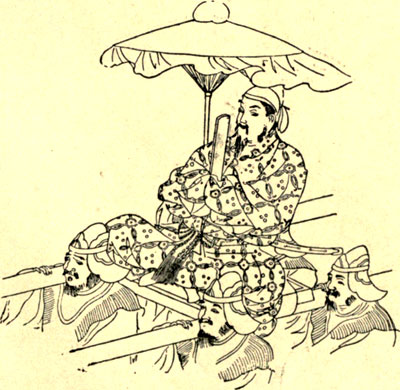 |
The Chinese constitution offered a solution of these
difficulties, on which the Emperor or his councillors gladly seized. In the great neighbour empire the
monarch's person was unapproachable to the mass of the population. He ruled by
means of his officials, of whom he saw none but the highest. Everything in the
country, men as well as land, was his property, and wholly subject to his will,
as exercised through Ministers in the capital and viceroys in the provinces.
The constitution of the Japanese Empire now underwent
a change in accordance with these principles. The Mikado was nominally at the
head of the Government: in practice, though not as a matter of right, he was
confined to the precincts of his palace, and as time went on became more and
more a stranger to his subjects. Ultimately he became, what he remained until
1868, a mythical personality, for the possession of whom disputants would
fight, because this alone could give to their measures the stamp of legality;
but a personality who could only give expression to his will when his servants
provided the means to this end, with a view to their own advantage and aggrandisement. The executive power lay in the hands of the
central administration, which had been remodelled after the Chinese pattern. This body was controlled by anyone who had
sufficient strength or cunning to make himself master of the situation. From
the heads of tribes a court nobility, the Kugé, was
created, from which were selected the high officials of the central
administration and the viceroys of the provinces and departments.
The tribes, as such, lost the political and economic
importance which they had hitherto possessed, and their property was no longer
held in common. Their place was taken by the family, the Ko, in which the
individual member had greater freedom of action. On the other hand, again after
the Chinese model, freedom was limited and the solidarity of family life
increased by the introduction of a new system of police, to which the history
of early England supplies a striking parallel. The Ko were organised in groups of five, and each group became answerable in common for its members :
this regulation seems to have been further strengthened by the creation of
similar unions of ten families, or twenty, and so on. Only a few of the
greatest tribes, such as the Fujiwara, the Taira, and the Minamoto, retained
that influence which the Uji had formerly exercised, and this in spite of the
fact that the unity of the members on which the strength of the Uji had rested
was now a thing of the past. We may, however, conclude that these families, and
especially the Fujiwara, were the chief agents in the introduction of this
change, which exercised so great an influence upon the whole of Japanese
internal development that the battles of the next eight hundred years were,
almost without exception, fought out between and within such tribes.
KWAMMU, WHO ESTABLISHED THE LAW OF SUCCESSIONHe reigned 782-806, ending a long series of struggles as to the succession. |
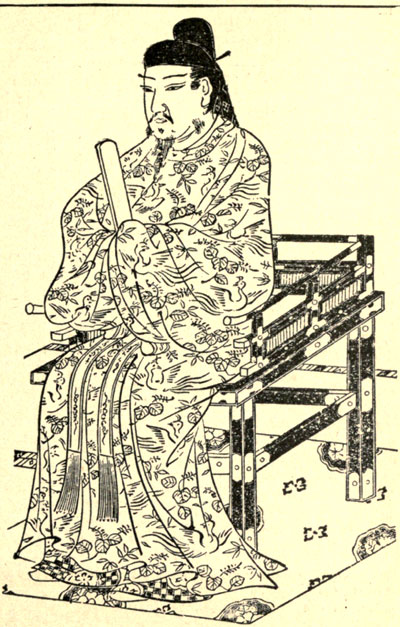 |
Such a change was naturally slow of completion.
Initiated and supported by Chinese and Buddhist influences, which began to make
themselves felt in the sixth century, a necessary condition of its
accomplishment was the downfall of the existing system, the reduction of the
Emperor's position, which that system strengthened, and, above all things,
energy and decision. As early as 603 A.D. the Empress Suiko created twelve new grades of nobility; in 647 these were reorganised in thirty subdivisions by the Emperor Kotoku. In this
institution we may trace the origin of the Kugé, the
Court nobility. In 603, eight Ministers of the Imperial palace were created, to
deal with administration and education, ceremonies, finance, and the census,
military affairs, the judicature, the exchequer, and the domestic economy of
the palace.
At this time the "Counsellor of the Gods of
Heaven and Earth" (Jingi Kwan), who had
previously been a supreme authority, was deprived of his dignity by the
progress of Buddhist influence. In 786 the Daijo Kwan
was created, a board of the chief officials of the realm, consisting of four
Ministers (the princes and the chief of the Kugé);
these were the great Minister of the Great Government (Daijo Daijin), the Sadaijin and
the Great Ministers of the Left and Right (Udaijin),
and the Privy Councillor (Naidaijin).
The entire government was in the hands of these officials. Finally, in the year
889 the hereditary dignity of the Kwambaku or Regent
was created.
Other changes exerted a deeper influence upon the
social organism. Under the Emperor Kotoku (645-654),
a succession of regulations called the Taikwa laws
(this being the name of the year-period in which they were issued), withdrew
from the Uji the offices which had hitherto been connected with them, and
arranged that these offices should henceforward be held only by men of proved
capacity. The members of the Uji now became vassals of the Empire, and the land
was divided into provinces (kuni) and districts (kori), the inhabitants of which were now responsible to the
Emperor for the payment of taxes in kind and the performance of labour services. In the year 689 was promulgated the
"Taiho "—that is, the existing body of legislation reduced to writing.
The most important point of this code was the
introduction of a system that had existed in China from immemorial antiquity,
the division of the arable land, all of which henceforward belonged to the
emperor, into temporary family holdings (on leases of six or twelve years). The
size of these was proportioned to that of the families that held them, and rent
was paid in the form of produce and of labour services. Forest, moorland, etc., remained common property. If the peasant
brought fresh land under cultivation, he had the right of usufruct for a
considerable period free of taxation, and this right he could even sell to
others with the consent of the authorities.
At a later period this system of land tenure became
the basis for the formation of the feudal state; at that time the territorial
lords claimed to stand in the position of the emperor toward the tenants,
raised the taxation upon arable land from three to fifty per cent.,
appropriated the common land, and respected only those articles of the code
which happened to correspond with their own convenience. Under this system the
possessions of the temples and monasteries increased with unusual rapidity; in
addition to the land which they gained by making clearings for cultivation,
they acquired, notwithstanding repeated prohibitions, rich presents and
legacies, which enabled the priests during the wars of the coming century to
play a part by no means in consonance with their vows of poverty.
In the year 669 Nakatomi no-Kamatari received from the Emperor Ten-ji, who favoured his desires, the family name of
"Fujiwara", indicating his place of birth. His family was of divine
origin; their ancestor was Amano-koyane no-Mikoto.
One of their forefathers had accompanied Jimmu on his
campaign, and had received from him the daughter of a subjugated prince in
marriage another member had taken the family name of Nakatomi under the Mikado Kimmei (540-571). Thus the Fujiwara
were the oldest and most distinguished clan in the country after the Mikado's
family. Of one hundred and fifty-five families composing the Court nobility (Kugé), the first ninety-five traced their descent from Kamatari, and it was from the first five of these, the Go-sekké, that the Mikado was obliged to choose his consort.
From 888 to 1868 the office of Regent and also that of Daijo Daijin was hereditary in this family.
Its influence was further increased by constant
intermarriage with the house of the Mikados, the
daughters of which almost invariably married into the same family. However, this
position of almost complete supremacy which the family had succeeded in
acquiring was destined to bring about the loss of its political power. In the
hands of the Fujiwara the Mikados were mere puppets,
generally children, and often in their tenderest years. The provincial
governors remained peacefully in Kioto, and sent
substitutes to occupy their posts. If a Shogun were appointed to deal with a
revolt of the Aino or of some governor, he left others to do the work, and
remained at Court to lead the life of pleasure for which he found there all
possible provision. Japanese literature centred round
the Court of the Mikado, and in this epoch attained its zenith; but the period
was also one of extreme luxury and unbridled immorality.
The real power passed by degrees into the hands of
those who did the work of the Government. While the effeminacy of the Court
nobility increased, a stronger caste rose into prominence, the Buké, who may be defined as a military nobility. The chief
representatives of this caste were the two families of the Taira and the
Minamoto. The former traced their descent from Takamochi,
the great-grandson of the Emperor Kwammu (782-806),
while the latter family were descended from Tsunemoto,
a grandson of the Emperor Seiwa (859-880); both were
originally members of the Court nobility, five families of which, as late as
the year 1868, retraced their origin to the Taira and seventeen to the
Minamoto.
|
|
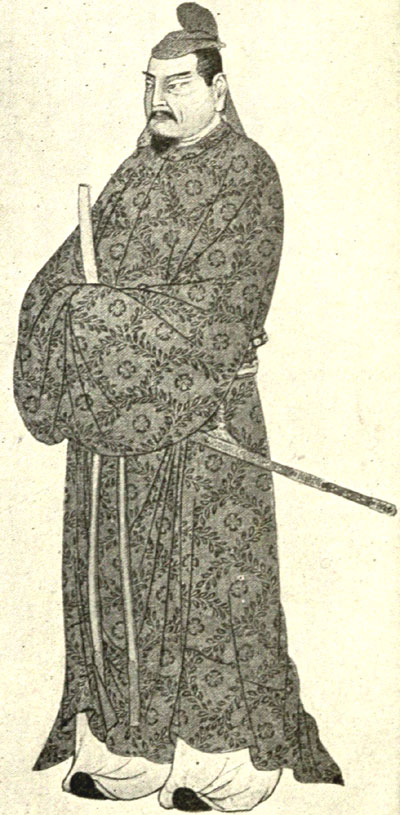 |
The first serious danger with which the Fujiwara were
confronted arose from a struggle for precedence against the kugé family of the Sugawara, who were no less ancient than themselves. The conflict
was fought out amid the intrigues of Court life, and ended with the overthrow
of Michizané, the representative of the Sugawara
family, who was defeated in the reign of Daigo (898-930) and sent into exile. More dangerous was the revolt of one of the
Taira, who set himself up as emperor in the Kwanto under the Mikado Shuzaku (931-946), and was supported
by some members of the Fujiwara; the movement, however, was suppressed after a
bloody conflict. The influence of the Fujiwara in Kioto remained unimpaired until the beginning of the twelfth century. The Taira were
active in the south and west, the Minamoto in the north and east, where they
won a great military reputation, and gathered bands of bold and predatory
warriors around them. Both parties were fully occupied with wars against the
Aino in the north, and against the Koreans, who had invaded Kyushu in the
south.
Meanwhile, both the Taira and the Minamoto began to
acquire influence in the capital. A favourite of the
Emperor Toba, by name Taira no-Tadamori, had a son by
one of his master's concubines (or by a servant of the palace whom he married
later) in 1118, whom he named Kiyomori. In the
disputes concerning the succession which broke out upon the death of the
Emperor Konoye in the year 1155, the two chief claimants for the throne were Shutoku, a former Mikado, who had abdicated in 1141, and
now claimed the imperial title for his son, and Go-Shirakawa, one of the sons
of the Emperor Toba, who had abdicated in 1123. Almost all the Minamoto
supported the first of these claimants, while the cause of the other was
espoused by the Taira.
The latter succeeded in obtaining the election of
Go-Shirakawa; Kiyomori, who had inherited all the
dignities and offices of his father, offered to support him. In the battles
between the two parties, Yoshitomo, a member of the Minamoto, also fought on
the side of the Taira. The Minamoto were defeated at the battle of Taiken Gate; their leader, Yorinaga,
committed suicide, while Tametomo, a renowned archer,
was captured and banished. Kiyomori was rewarded with
the position of Daijo Daijin.
He now ruled as the Fujiwara had done before him. The Minamoto became the
special objects of his hatred, and he persecuted them with such ferocity that
in 1159 Minamoto no-Yoshitomo, who had previously been on his side, declared
against him. He, however, was quickly overpowered, and murdered while in
flight.
|
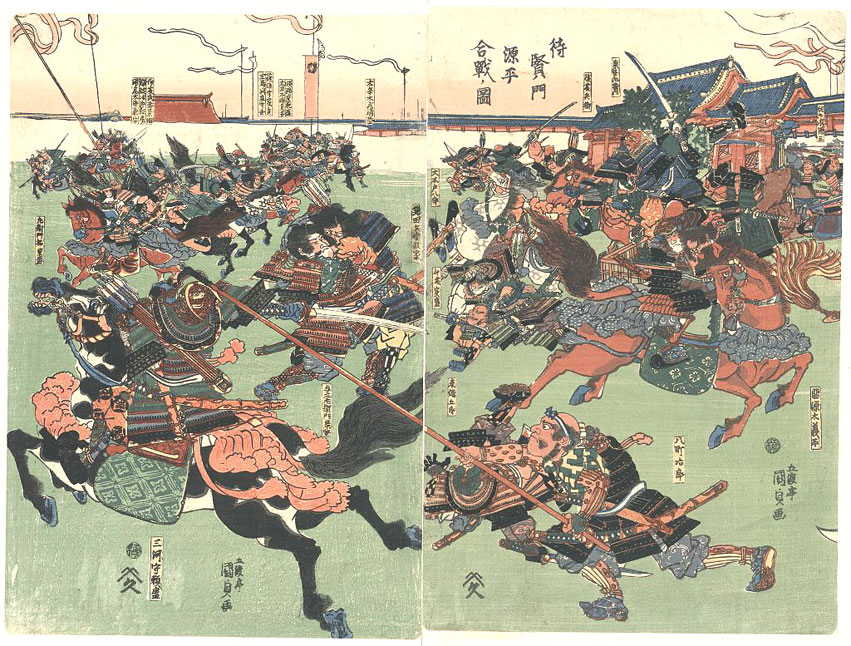 |
This victory gave Kiyomori absolute predominance. His father-in-law, the Mikado Go-Shirakawa, who had
abdicated in 1158, was carried off and sent into exile, and the war of
extermination against the Minamoto continued. Yoritomo, the fourth son of
Yoshitomo, escaped the fate of his brother owing to the pleading of the sons of Kiyomori, and was sent into exile. Three of his
half-brothers, including the famous Yoshitsune, who
was then an infant at the breast, were spared for a like reason. Their mother,
the fair and clever Tokiwa, a peasant woman by birth,
who had been the concubine of Yoshitomo, saved them after they had been cut off
from flight by offering herself to the victor as his concubine. Yoritomo, who
had married the daughter of Hojo Tokimasa,
the man to whose custody he had been committed, raised the standard of revolt
against the Taira. His first attempt ended in disaster; but he escaped to the Kwanto, soon collected a force, and fortified himself in
Kamakura, where the Taira did not venture to attack him. Shortly afterwards
(1181) Kiyomori died; his last words to his family
were that the observance of the usual burial customs was to be omitted in his
case, and that the only monument to be set up before his grave was the head of
Minamoto no-Yoritomo.
His son Munemori possessed
neither the capacity nor the bloodthirsty energy of his father. He wasted
valuable time in deliberation while his enemies in the north, who were joined
by the remnant of the Minamoto, grew more powerful every day; their cause was
also espoused by many of the Fujiwara, by the priests of Hieizan,
and by the exiled Go-Shirakawa. The first conflict took place in the mountains
of the Nakasendo, between n army of the Taira and Minamoto no-Yoshinaka, whose father had also been a
victim of Kiyomori. The Taira were utterly beaten in
1182 and Munemori fled from Kioto with the young Mikado Antoku. There the old
Go-Shirakawa greeted the conqueror upon his entry. Antoku was declared to be deposed, and Go-Toba was elected Emperor in his place. He
appointed Yoshinaka to the post of Shogun, so that this personage now became
leader of the opposition to the family of his cousin Yoritomo. Minamoto
no-Yoritomo sent his younger brothers, Yoshitsune and Noriyori, against him; they defeated him in 1184 at
Lake Biwa, and Yoshinaka committed suicide. Yoshitsune availed himself of this advantage to resume the pursuit of Munemori.
After a series of combats, all of which went against
the Taira, a decisive naval battle was fought in 1185 at Dan-no-ura, near Shimonoseki. The Taira made a most valiant
resistance, but were utterly routed. The widow of Kiyomori drowned herself with the Mikado Antoku, who was then
five years old. Most of the Taira who did not fall in the battle committed
suicide or were killed in the pursuit. A few found refuge in the remotest parts
of Kyushu, where it is said that their descendants may to this day be recognised. The utter ruin with which the Taira had once
threatened the Minamoto was now dealt out to them by the enemy they had
formerly conquered.
In certain respects the wars of the Taira and Minamoto
are analogous to the Wars of the Roses in England; the comparison can be
extended to the colours worn by the Japanese parties,
the standards of the Minamoto being white and those of the Taira red. The events
of these wars form the subject of the most famous Japanese novels, which are to
this day the delight of young and old.
The following four centuries of Japanese history are
filled with indiscriminate fighting. Law and order are non-existent, treachery
and murder are of daily occurrence, and our contempt for the faithlessness of
the nobles to the Mikado, the Shogun, and the Regent is increased by the
numerous instances of the fidelity displayed by the lower orders towards their
masters. Each individual is concerned only with his own advantage and the
easiest means of obtaining it. The one inspiring feature of the period is the
stoical courage with which the conquered, who as conquerors were merciless, met
their death—they fell upon their own swords, after the manner of the ancient
Romans.
TAMETOMO, THE GREAT ARCHER defying his enemies in
battle against the Taira families, about 1155
|
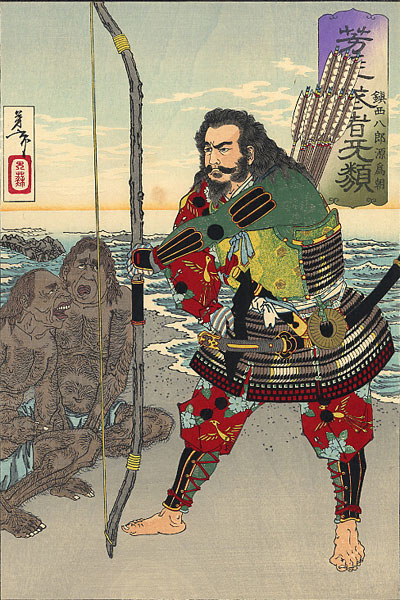 |
At the outset of the rule of the Fujiwara in the
eighth century the necessity became apparent, probably owing to the growing
effeminacy of certain classes of the population, for the creation of a special
military class (the Samurai). At an earlier period every man was a soldier, and
marched when he received his summons; now this militia was replaced by a class
of professional soldiers. Instances occur at an early period of the existence
of bodyguards of which the military forces of the greater lords may have been
composed; these, however, are purely exceptional cases. As in Anglo-Saxon
England and in Europe at large during the ninth and tenth centuries of our era,
the necessities of the time obliged the free peasants and often the petty
nobles of Japan to place themselves under the protection of a more powerful
lord, and to give up their freedom in return for the security which he could
offer them.
An additional piece of evidence for this fact is the
argument invariably adduced by the Japanese themselves during the debates on
the proposal to capitalise the incomes of the Samurai
(1870-1880), that this order of nobility, or rather gentry, had originated from
the peasant class in the eighth century and ought to revert to that condition.
The peasant serfs, like those who voluntarily sought the protection of a lord,
owed military service to this lord, and not to the Emperor; eventually, in view
of the unbroken continuance of war, both parties, lord and peasant, found it to
their advantage to draw a more definite line of demarcation between the
productive and the military classes.
Similar circumstances no doubt gave rise to the great
fiefs. In the times when might was right, the regent, the field-marshal, or
whoever was in power for the moment, either seized the property of a defeated
enemy for himself or divided it among his adherents. At a later period, when an
increased number had been able to carve a kingdom for themselves out of the
property which theoretically belonged to the Emperor, when the country was
divided among great and small lords, actual possession formed nine-tenths of
the law, and often the whole of it; whether the possessor of land had been duly
and formally invested with it was a matter of total indifference. What the
sword had won, the sword alone could keep. So when social conditions became
more stereotyped at the beginning of the seventeenth century, the whole of the
country was in possession of greater or smaller lords, who held their lands in
theory from the Mikado either directly, or mediately through the Shogun. The
theory became practice when, upon the restoration of the Mikado's power, the
landed property and all the inhabitants of the empire were claimed as Imperial
possessions by the Government.
From the victory of the Minamoto over the Taira until
the restoration of the Mikado in 1868, a period of almost seven centuries, two
facts are of primary importance for the internal development of Japan. First,
that whereas Kioto had hitherto been the social and
political centre of the country, this centre of gravity was now transferred to the northeast,
first to Kamakura, a foundation of Yoritomo, and afterward to Yedo, founded by Iyeyasu. The second fact is of no less
importance : during the greater portion of this period the actual power was not
exercised by the bearers of the different titles of office, the Mikado, Shogun,
and Regent, who were generally children, and sometimes babes in arms; the
strings of government were pulled by relations and other personages behind the
scenes. Extremely rare are the cases in which the bearer of the title plays
anything but a passive part, and that, too, at a time when there was certainly
no lack of vigorous and energetic men in Japan.
The victory of Dan-no-ura was followed by an outbreak of serious dissensions within the Minamoto family,
evoked by the jealousy of Yoritomo at the military success of his half-brother, Yoshitsune; shortly afterward the latter was murdered
by order of Yoritomo. The personality of this most attractive of all the
Minamoto has become the nucleus of a cycle of legends; the most probable story
says that he committed hara-kiri, after killing his wife and children, and that
his head was brought to Kamakura, to be shown to his brother as evidence of the
execution of his orders.
| Yoritomo (1147-98) belonged to the Minamoto family. He
spent his life in fighting. He instigated the murder of his half-brother, and
won renown as the first Shogun,
|
 |
Yoritomo himself was invested in 1192 with the title
of Sei-i Tai Shogun, "the great general subduing
the barbarians". He died in 1199. Upon his hereditary estates in the
eastern provinces he instituted a properly organised system of government, the "Baku-fu," indicating the "curtain
screen" which surrounded the tent of the field-marshal. This system
corresponded in some respects with the military administration of the
field-marshal; the incompetent provincial governors were replaced by capable
subordinates of his own. Under him Kamakura became a large and beautiful town,
of which only a pair of stately Shogun temples now remain, together with the
colossal statue of Buddha and the simple sepulchre monument of its founder.
After the death of Yoritomo his father-in-law, Hojo Tokimasa, together with his
widow, Masago, acted as the guardians of Yori-iye, who was then eighteen years of age; after a rule
of four years he was deposed in 1203, sent into exile, and murdered a year
later. He was succeeded by Sanetomo, a brother eleven
years of age, who was murdered in 1219 by his nephew Kokio,
the son of Yori-iye. The main branch of the family of
Yoritomo thus became extinct, and power remained in the hands of the Hojo family. They did not themselves assume the title of
Shogun, but contented themselves with that of Shiken (regents) of Kamakura, preferring to appoint children of the Fujiwara family,
or of the Imperial house, to the position of Shogun, and ruling under their
names. Of the eight Shoguns included in the period 1220-1338 six were between
three and sixteen years of age at the time of their appointment; all were
deposed, and two are known to have been murdered. In the family of the Regents
things were no better; eight rulers succeeded one another in the years 1205-1326,
and three or four in the short space between 1326 and 1333. The family then
became extinct.
The assumption of the power by the Hojos caused much dissaticfaction in Kioto.
The three ex-Mikados, Go-Toba and his sons Tuschi and Juntoku, together with
the son of the latter, Chukyo, who had been ruling from 1222, offered
resistance but were overpowered; the three exMikados were sent into exile and there thrown into prison, while the reigning emperor
was deposed. The first of the Hojo Regents, or their councillors, were men of high capacity. Yoshitoki (12051224) and Yasutoki (1225-1242) did their utmost
to maintain peace throughout the country, but were forced to struggle against
the parties in Kioto and the Buddhist priests,
especially in Yamato, who stirred up the population against them. Tsune-toki ruled for only three years (1243-1246), and
abdicated in favour of his younger brother Tokiyori (1246-1256). He, too, gave proof of much energy
and made special efforts to improve the administration of justice.
 |
The greatest services to Japan during that period
were, however, those of Toki- mune (1257-1284). After
his conquest of China, Kublai Khan sent a letter by the Koreans to the Mikado
Go-Uda (12751287), demanding the recognition oi his
supremacy and the payment of tribute from Japan. Tokimune scornfully rejected the demand. The Mongol ruler of China continued his
diplomatic efforts, but with no greater success. The Mongols then took
possession of the islands of Tsushima and Ikishima,
making Korea their base of operations, and attempted, in 1275, to establish
themselves in Kyushu, but were driven back. In the year 1279, Chinese
ambassadors again arrived at Nagasaki with demands for the submission of the
country, but were beheaded by the orders of the Kamakura government.
AN EMPEROR MEETING HIS NOBLESA reception of Japanese nobles in the days when the Emperor was still visible. |
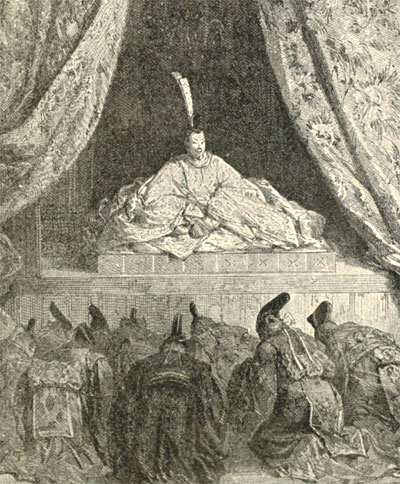 |
Finally, in 1281, a powerful Mongol fleet appeared off
the coasts of Kyushu. The Japanese annals are full of stories concerning
individual deeds of valour performed in the repulse
and destruction of this armada. The truth appears to be that the fleet of
between 3,000 and 4,000 sail, carrying 100,000 warriors (some accounts say
300,000), including 10,000 Koreans, was almost entirely destroyed by a typhoon,
and the Japanese then made an end, without loss to themselves, of such of the
crews and troops as had been saved.
This success, and the absolute power which they
exercised in the empire, tempted the Hojos to disregard
the most ordinary dictates of prudence and common sense.
Hitherto they had ruled with an iron hand, had deposed
and appointed Mikados and Shoguns at their pleasure;
but their measures had been actuated by desire for the national welfare. Now,
however, they and their officials began a course of appalling oppression of the
lower classes, in order to provide themselves with the means for luxury and
dissipation. Dissatisfaction and irritation increased, until at last, in 1330,
the Mikado, Go-Daigo, the fifth who had ruled since
1287 and himself a nominee of the Hojos, raised the
standard of revolt. One of his sons, Mori yoshi, had
previously attempted, in 1327 to shake off the yoke which lay heavily upon the
Imperial house and the country, but his plot had been discovered and he was
sent into a monastery. His father was equally unfortunate; he was conquered,
deposed, and sent into exile. Kusunoki Masashige, who
had revolted in Kawaji, was also defeated, but
escaped capture. The country now appeared to be bound more firmly than ever in
its chains; but salvation was to come from the family of the Minamoto. Two
grandsons of Mina-moto Yori-iye, the
great-grandfather of Yorimoto (known in Japanese
history as Hachiman taro—that is "eldest son of the war god"), had
founded two families—the Nitta and Ashikaga, who now revolted against the Hojo. Nitta Yoshisada, who had
formerly been in the service of the Regents, allied himself with Moriyoshi (now called Otono Miya)
in 1333, collected h s adherents and those of his family, and made a forced
march upon Kamakura, before which he appeared on the fourteenth day of his
revolt. Takatoki, who had himself resigned the
regency in 1326, was then conducting the government for the last of the child
regents. He was completely taken by surprise. The castle of Kamakura was
captured after a short resistance. Takatoki and a
large number of his adherents committed suicide, while the remainder were slain
by the conquerors or by peasants who joined in the revolt. At the same time
Ashikaga Takauji, in alliance with Kusunoki, had broken the power of the Hojos in Kioto. There also all
the adherents of the Hojo were slaughtered wherever
they could be caught. Even at the present day in Japan the memory of the Hojos is regarded with abhorrence.
THE EMPEROR GO-UDA, IN WHOSE REIGN THE MONGOL ARMADA WAS DESTROYEDThe strong man in the reign of Go-Uda (1275-1287) was Tokimune, who urged the Mikado to refuse the demands of Kublai Khan for tribute. The Mongols then invaded Japan with 100 ,000 men, and the armada was destroyed by a typhoon. |
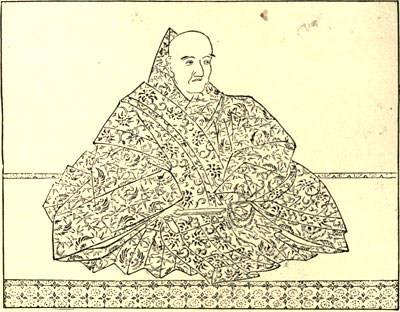 |
GO-DAIGO, THE UNFORTUNATE EMPEROR, DRIVEN TO HOLD COURT IN THE MOUNTAINS |
 |
FOUNDER OF A LINE OF SHOGUNS Ashikaga Takauji, founder of the Ashikaga line ot Shoguns, lasting from his accession in 1334 to 1573. |
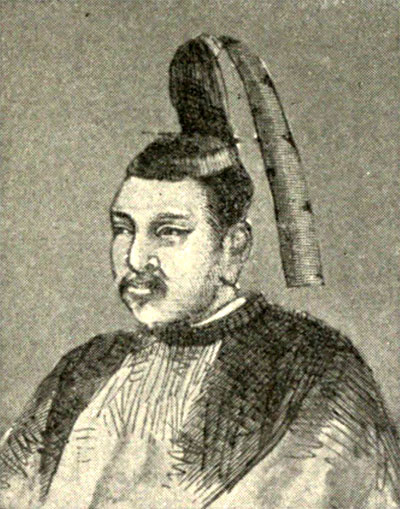 |
Upon the success of his friends the exMikado Go-Daigo returned from
exile and again ascended the throne in 1334. He appointed his son Moriyoshi as Shogun of Kamakura, and rewarded Ashikaga
Takauji with Hitachi, Musashi, and Shimosa; Kusunoki Masashige was
rewarded with Setsu and Kawaji: while Nitta Yoshisada received Kozuke anti
Arima, many others receiving smaller possessions.
Peace and unity were not, however, to endure for long.
Go-Daigo in Kioto and Moriyoshi in Kamakura led a life of debauchery that shocked
even the carelessness of that age. A former Buddhist priest, under the pretext
of seeking for adherents of the Hojos, overran the Kwanto, robbing and murdering at the head of a mob of
ruffians, until he was crucified by the orders of Takauji. Moriyoshi availed himself of the opportunity to make clamorous complaints to his father,
until at last a younger brother ot Takauji,Todoyoshi, revolted and proclaimed a new Shogun. At
first the two brothers fought upon different sides, but ultimately they joined
forces, marched together upon Kamakura, and expelled Moriyoshi.
Takauji now proclaimed himself Shogun. Go-Daigo summoned his adherents, including Nitta Yoshisada,
for war against the pretender. Nitta, however, after obtaining some initial
success, was defeated at the pass of Hakone. Takauji now marched upon Kioto, and Go-Daigo fled, bearing
the insignia of empire to the fortified temple of Miidera,
near Mount Hie, but was ultimately driven out.
Meanwhile, his adherents had collected and in their
turn expelled Takauji from Kioto and Miidera, but were ultimately defeated with crushing loss at Minatogawa, near Hiogo.
Kusunoki Masashige, the commander of the Imperial
troops, fell in the battle. Go-Daigo fled to Miidera once more, and in 1337 Takauji appointed a younger
son of Go-Fushimi (1299-1301) as Mikado under the name of Komiyo Tenno. Ultimately the conflicting parties came to an agreement upon the terms
that the position of Mikado should be occupied for alternating periods of ten
years by the descendants of Go-Daigo and those of
Go-Fushimi. Go-Daigo temporarily restored the
insignia of empire, and Komiyo was crowned. Takauji
became Grand Shogun and resided in Kioto, while his
son Yoshimori remained in Kamakura as Shogun. Under
the latter a Shiken at Kioto dealt with the affairs of the western provinces, while a governor (Kwanrei) ruled over the eastern provinces from Kamakura.
However, the peace between the two parties was not destined to be permanent. In
the same year (1337) Go-Daigo declared himself the
only legal Mikado, and proclaimed his opponent illegitimate, collecting round
him his adherents, the chief of which were Kusunoki Masayuki, the son of Masashige, and Nitta Yoshisada.
Henceforward until the end of the century two Mikados ruled in Japan, one in the south and another in the
north, the former of whom was considered as the legitimate ruler, while the
latter possessed the real power. Meanwhile, the supporters of the southern
Mikado were destroyed one after the other, and in 1392 a convention was
arranged providing the same conditions as the agreement of 1337. Go-Kameyama Tenno, the second of the southern emperors, who
had been nominal ruler since 1366, resigned, and surrendered the insignia of
the empire to his opponent in the north.
Takauji died in 1358, at the age of fifty-three. He
was succeeded by his son Yoshimori, who abdicated in
1367; his grandson Yoshimitsu, who also abdicated, in
1393, lived till 1409, and exerted a highly beneficial influence upon the
Government. Under him the empire enjoyed for a short space the peace of which
it was greatly in need. Soon, however, dissension broke out again among the
different familieswho had gained power and prestige
in the wars of the last century. The Hosokawa, Takeda, Uyesugi,
Tokugawa, Ota, and Odawara in the north and centre of the country, the Mori in the west, the Satsuma, Hizen, and Bungo, in Kyushu, were continually at war with
one another and with their neighbours. The Ashikaga
were powerless to restore peace and order until the last of them, Yoshiaki, was
deposed in 1573 by Ota Nobunaga.
The country was in a terrible condition; on every side
were to be seen devastated fields and the ruins of formerly flourishing towns
and villages. Kioto itself was a heap of ruins; all
who could leave the capital had fled long since to take refuge in the camp of
one of the great territorial lords. The prestige of the Mikado had sunk so low
that in 1500 the body of Go-Tsuchi stood for forty
days at the gates of the palace because the money for the funeral expenses was
not forthcoming. The peasant class had been almost entirely exterminated; every
peasant who had strength had become a soldier or had joined one of the
piratical hordes which raided the coasts of China, Korea, and Japan. The
condition of the country may be compared with that of Germany during the Thirty
Years War, and even as the German princes of that time begged support from
foreign countries, France, Spain, and Sweden, so the Shogun Yoshimochi at the beginning of the fifteenth century requested the Emperor Yung lo of the
Chinese Ming dynasty to grant him the title of "King of Japan", and
obtained his request in return for the yearly payment of a thousand ounces of
gold.
The fall of the Ashikaga family was brought about by
the action of its own adherent, Ota Nobunaga. This youth was descended from a
grandson of Taira no-Kiyomori, who had been secretly
left in charge of the magistrate of the village of Tsuda by his mother when in
flight before the soldiers of the Minamoto; shortly afterwards the magistrate
handed him over to a Shinto priest from Ota, living in Echizen, who adopted him
as his son. The boy grew up, entered the profession of his foster-father; and
founded a family from which, in 1533, nearly 400 years later, Nobu- naga was born.
The immediate ancestors of the latter had taken an
active share in the disturbances of the period; his father, Ota Nobuhidé, who died in 1549, bequeathed to him possessions
of considerable importance. The son entered the service of the Ashi- kaga, and succeeded in
adding to his hereditary property until he found himself in possession of six
provinces and the capital of the country. Among his retainers were included
Kinoshita Hideyoshi and To-kugawa Iyeyasu (a Minamoto), two men who were to play a great part in the history of
Japan. In 1573, Nobunaga quarrelled with the
Ashikaga, marched against them, and defeated the Shogun Yoshi-aki, whom he captured and deposed.
THE BAYARD OF OLD JAPANKusunoki Masashige, who lived in the firsthalf of the 14th century. The pattern of devoted loyalty, he destroyed himself after being defeated in the battle of Minatogawa in 1336. |
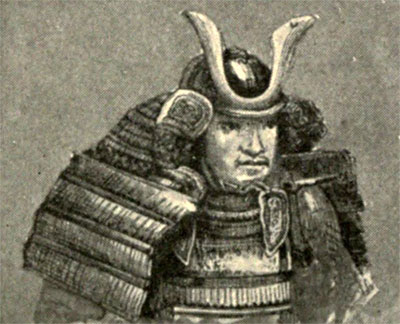 |
This event ended the dynasty of the Ashikaga Shoguns.
As Nobunaga was not himself descended from the Minamoto, he could not be Shogun,
and therefore governed under the title of Nai-daijin.
His struggles against the Buddhist monks and the preference which he showed for
the Christians are dealt with in the chapter on the religions of Japan. His
rule lasted but a short period (1574-1582), too short to enable him to restore
peace to his country. The battles against the powerful princes in the west of
Hondo and in Kyushu continued uninterruptedly, and while Hideyoshi was leading the greater portion of the troops of his master against Mori in the
west, Nobunaga fell a victim to treachery. He had insulted Akechi Mitsuhide, one of his generals; this leader, who had
been dispatched with the remainder of the troops upon another expedition,
suddenly halted under the gates of Kioto, incited his
soldiers to revolt, entered the city with them, and surrounded the temple of Honnoji, in which Nobunaga had established himself.
Surprised by the appearance of so many soldiers, Nobunaga opened a window in
order to inform himself of the state of affairs. An arrow struck him in the
arm, and, seeing that his cause was lost, he closed his career by hara-kiri,
committing suicide after commanding the women of his company to flee, and
setting the temple on fire. The traitor assumed the title of Shogun, but twelve
days later he was defeated by Hideyoshi, who had
hurried to the spot. The general was utterly routed, and slain while in flight.
IYEYASU, THE GREATEST RULER OF JAPAN IN PEACE AND WAR
Iyeyasu (1542-1616) obtained, in 1603, the title of
Shogun, which continued in his family until 1868, when the Shogunate was
abolished. It was he who isolated the Emperor in Kioto and concentrated power in the Shogunate.
|
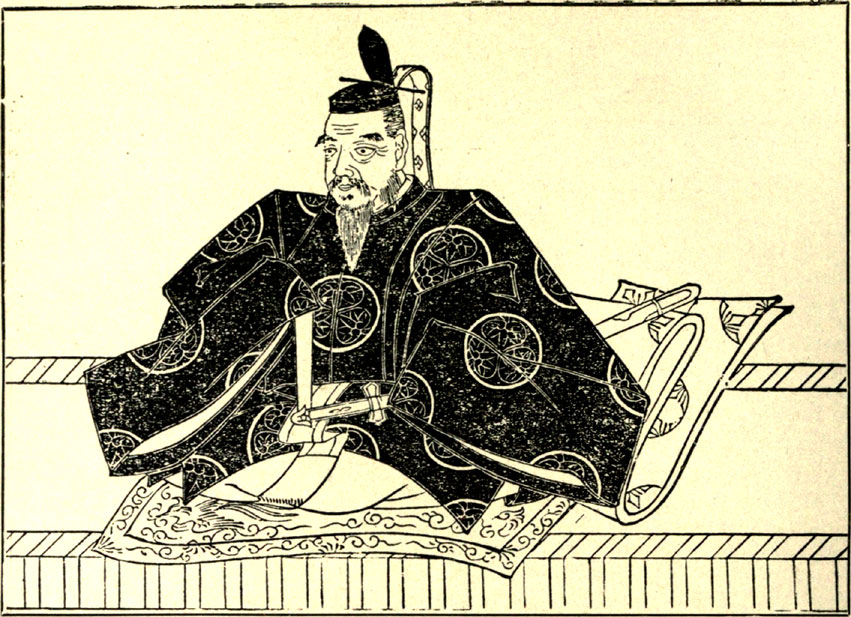 |
HIDEYOSHI, WHO, BORN A PEASANT, BECAME THE NAPOLEON OF JAPANHideyoshi (1536-88) rose to power by his great military capacity, and established good government and prosperity. He could not assume the title of Shogun, not being of noble birth, but was Chief Counsellor to the Emperor. |
 |
HIDEYOSHI was the son of a peasant, and was born in
1536 at Nakamura, in Owari. At an early age he
enlisted in the service of Nobunaga, under the name of Kinoshita Tokichiro. Here he quickly gave proof of bravery and
military skill, and eventually became the most capable and trustworthy general
of Nobunaga. At the time of the attack upon the latter he was opposing the
troops of Mori in company with Nobunaga's son, Nobutaka;
with him he quickly came to an agreement, and was thus enabled to turn his
steps to Kioto with the success we have already
described. Of the three sons of his former master, one was already dead,
leaving behind him a son, who nominally continued his grandfather's rule from
1582 to 1586 under the name of Samboshi. The second
son was now with Iyeyasu, who was pledged to prevent any outbreak on his part.
The third son, Nobutaka, entered into alliance with a
brother-in-law of his father, by name Shibata, who was in possession of
Echizen, but was unable to make headway against Hideyoshi.
He was defeated, and his ally was also overpowered in Echizen by the pursuing
enemy.
The narrative of the death of Shibata is one of the
most impressive incidents among the many moving events of Japanese history.
Besieged in his castle at Fukui, with no hope of relief, Shibata resolved to
die. He invited all his friends and adherents to a feast, at the conclusion of
which he informed his wife, the sister of Nobunaga, of his determination, and
gave her permission to leave the castle and save her life. The brave woman,
however, declined to avail herself of the opportunity, and demanded to be
allowed to share her husband's fate. Shibata and his comrades then slew their
wives and children—who thanked them that they had thus been privileged to die
with them—and then committed hara-kiri. All were buried in the ruins of the
castle, which they had previously set on fire.
Hideyoshi succeeded in restoring peace and order to the
country, though at the price of a severe struggle. Iyeyasu was ruling in the Kwanto, the eight provinces of the East, with which he had
been invested by Hideyoshi, and is said to have built
himself a capital at Yedo on the advice of Hideyoshi. Possibly the political recollections and
sympathies of the latter made it, in his opinion, far more desirable to have
the powerful Minamoto, who had been subdued only at the cost of a long
struggle, resident in Odawara, the headquarters of
the Shoguns subsequent to the destruction of Kamakura. Between Iyeyasu and Hideyoshi there existed a general understanding, which was,
however, modified by their mutual suspicion. The former, for instance, declined
to go to Kioto to have an audience of the Mikado
until Hideyoshi, who was staying in the city, had
handed over his mother as a hostage.
The most important prince in the west, Mori of Nagato
(or Choshu), had also made submission to Hideyoshi; and the most powerful prince in Kyushu, Shimazu
of Satsuma, who had made himself almost absolute master of the island after
struggles with Riuzogi of Hizen and Otomo of Bungo, was utterly defeated after a
campaign of many vicissitudes, in which Hideyoshi himself was ultimately obliged to assume the command (1386-1587). Why Hideyoshi did not entirely destroy this most powerful and
restless of his opponents is a doubtful point. He allowed the son of the
conquered man, who was forced to abdicate and to accompany the victor to Kioto as a hostage, to remain in possession of his father's
territory, alleging as a reason for this clemency that he did not wish to
exterminate their ancient family.
This, however, seems an extremely unlikely motive in
the case of so practical a politician as Hideyoshi.
It is more probable that he hoped by the exercise of kindness to gain the
gratitude of the Prince of Satsuma and of his father, and then to use them as a
counterpoise to the other princes of the south and west.
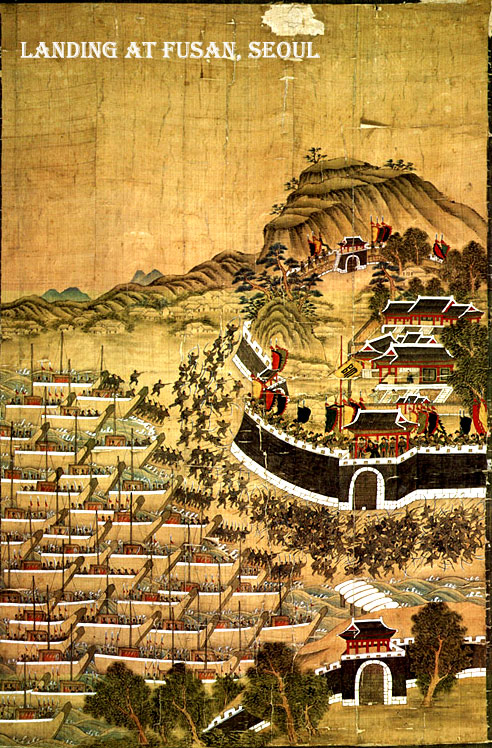 |
As soon as peace was restored throughout the empire, Hideyoshi proceeded to attempt the great ambition of his
life, which he is said to have entertained from early youth—the conquest of
Korea and China. In 1582 he had demanded of the King of Korea the tribute which
had formerly been paid to Japan. At a later period he had required that Korea
should form his first line of defence in his war
against China, where the Ming dynasty was in power. Upon the rejection of these
demands, he sent an army of nearly two hundred thousand men against Korea in
the spring of 1592. His first successes were as rapid as they were sweeping.
Eighteen days after his landing at Fusan, Seoul, the capital, fell into the
hands of the Japanese. The army speedily advanced to the Ta-tong river and
overpowered the town of Ping-yang, situated on the northern bank of that
stream.
At this point, however, his advance was checked partly
by the difficulty of obtaining supplies, but chiefly owing to the fact that the
Japanese fleet which was to cover his further advance had been defeated by the
Koreans. Shortly afterward the Chinese forces appeared which the Koreans had
begged might be sent to their help. The plans of the Chinese were also favoured by the jealousy existing among the Japanese
generals, one of whom, the Christian Konishi Yukinaga, was at the head of a column formed entirely of
Christians; while the other, Kato Kiyomasa, was a
Buddhist and hostile to the Christians. Almost a year after the capture of
Seoul, the Japanese were obliged to evacuate the town, which was not reentered
by a Japanese force for another 300 years (1894).
Military operations and negotiations between Kioto and Peking occupied the period ending with the year
1596. Upon the failure of the negotiations, Hideyoshi sent additional reinforcements to Korea in the year 1597, while the Chinese
also sent out another army, which advanced far beyond Seoul. Fortune at first favoured the Japanese. In October they had again advanced
nearly to the walls of Seoul; but a second victory of the united Chino-Korean
fleet and a threatening advance of the Chinese again obliged them to retreat,
in the course of which operation they utterly devastated the country through
which they passed. The Chinese pursued their retreating enemy to Ulsan, where
the beaten Japanese army took refuge. The Chinese made vain attempts to capture
the fortress until February 13th, 1598, when a Japanese division relieved their
besieged compatriots. With that event the great war ended. A few unimportant
skirmishes followed, but Hideyoshi, who died on
September 8th, 1598, recalled the expedition upon his deathbed. The only
outward token of success was the Mimizuka (the mound
of ears), a monument erected near Kioto, under which
the noses and ears of 185,738 slaughtered Koreans and of 29,014 Chinese are
said to have been buried.
Whether Hideyoshi was
actuated solely by the motives by which he declared himself induced to attack
Korea, or whether he was also attracted by the possibility of providing
occupation for the disorderly elements in the country, and weakening the
military power of the Christians, is a question which must remain undecided.
During his reign numerous prohibitions were issued against Christian teachers
and proselytes, but at the same time he continued the policy of Nobumaga against the Buddhist monks and destroyed their
monastery of Kumano among others.
He is certainly one of the best known figures in
Japanese history. Even at the present day he is an object of general reverence
to all classes of the population, and no doubt his Korean expedition largely
contributed to increase his reputation. But his government was a period of
prosperity for the country in other respects. Acting in the name of the
Emperor, he gave full support to law and justice, and in many branches of the
administration he not only established order, but effected great improvements
by new laws and regulations. We may presume that the attempt of his successor
Iyeyasu to reduce the country definitely to peace and order would have proved
fruitless without his preliminary labours. It is
customary at the present day to heap reproaches upon the dynasty of the
Minamoto Shoguns, but at the same time we must not forget that they gave the
country more than 250 years of peace after centuries of war and consequent
disruption.
Hideyoshi appears in Japanese history under different names. We
have already mentioned that under which he first entered the service of
Nobunaga. While a general he was known by the name of Hashima,
and afterwards the Mikado conferred upon him the name of Toyotomi.
He is, however, best known as the Taiko-Sama, the title usually assumed by the Kwambaku, or chief counsellor of the Emperor, upon laying
down his office. He could not hold the title of Shogun, as he did not belong to
the Minamoto family, who for nearly 400 years had been the exclusive possessors
of this dignity. However, at an advanced age he procured his adoption by one of
the Kugé belonging to the Fujiwara family, and was
thus able to take the position of Prime Minister (Kwambaku).
Like other great men, he was known by a number of nicknames, such, for
instance, as Momen Tokichi—
that is, "Cotton-cloth Tokichi", as he was
useful for every purpose, like cotton-cloth. After he had obtained the dignity
of Kwambaku he was known as the Crowned Ape (Saru Kwanja), on account of his
ugliness. Notwithstanding his high position and the great honour in which his name is held, his burial place in Kioto is unknown.
According to the Japanese custom, Hideyoshi resigned the post of Kwambaku in 1591 in favour of his son, but continued to exercise the actual
power. He married his six-year-old son (or adopted nephew?) Hideyori,
to a granddaughter of Iyeyasu, thinking thereby to secure the support of this
most powerful of the Imperial Princes. He appointed five councillors of the empire as regents. However, the actual government was in the hands of
the mother of Hideyori, the heir, a woman of
extraordinary beauty and energy. The peace that had been established was not
destined to endure for long.
A is by no means certain who was the first to break
it. The ambition of Iyeyasu, who, like other nobles, had been obliged to
acknowledge the capacity of the father but despised Hideyori,
the son, may have been the occasion of an open rupture. The outbreak of the
war, which was in any case inevitable, may also have been precipitated by the
regent's fear of the actual or supposed plans of Iyeyasu. The fact that the
most powerful princes of the west and the south, especially Mori and Shimazu,
were on the side of Hideyori, no doubt strongly
contributed to induce Iyeyasu, the champion of the east, to take up arms.
After long preparations and petty conflicts in
different places, in which Iyeyasu displayed both greater power and more
patient forbearance, matters came to an open rupture in 1600. In a battle
fought at Sekigahara, on Lake Biwa, not far from Kioto, Iyeyasu utterly defeated the allies, partly with the
help of treachery, and followed up his advantage with unexampled energy. Osaka
and Fushimi, which had been strongly fortified by the Taiko Sama, and formed
the key to Kioto, fell, one after the other, together
with the capital itself, into the hand of the conqueror. Many of the hostile
leaders committed hara-kiri; others, who declined as Christians to commit
suicide, were publicly executed; the remainder were forced to submit; while
those who favoured Iyeyasu were bound more firmly to
his cause by gifts of land and marriage alliances.
LAKE BIWA, THE SCENE OF IYEYASU'S TRIUMPHAt the battle of Sekigahara, near this lake, in 1600, Kioto, the capital, the year fell into Iyeyasu's hands. This and succeeding battles established Iyeyasu in the Shogunate
|
Notwithstanding this great success, Iyeyasu left Hideyori in possession of his position and dignities, and
merely limited his income by imposing upon him the duty of erecting castle
buildings and other expensive undertakings. The newly-discovered gold mines in Sado provided him with rich resources for the execution of
his further plans. In 1603 Iyeyasu was appointed Shogun. However, he soon
abdicated, and procured the appointment of his son Hidetada to this dignity in
1605, retaining the actual power in his own hands. Hidetada resided in Yedo, while Iyeyasu kept watch upon his opponents from
Suruga, 100 miles south of Yedo. In 1614 a new
conflict broke out, the result, no doubt, of the growing popularity of Hideyori. Iyeyasu and Hidetada attacked Osaka, the
residence of Hideyori, apparently without success.
After concluding the pacification they marched back towards Kwanto,
but suddenly wheeling round, reappeared before Osaka, and took the town after a
short struggle, being aided by treachery within the walls. During the storming
of the fortress Hideyori disappeared; Iyeyasu
himself, who had been wounded during the operations, died in the next year
(1615). The lords of the east had now definitely conquered the west, and the
advantage thus gained they were enabled to retain until the restoration of the
Mikado Government in 1868.
Katsura River and Kyoto City from Mount Atago where Shibata died under pathetic circumstances |
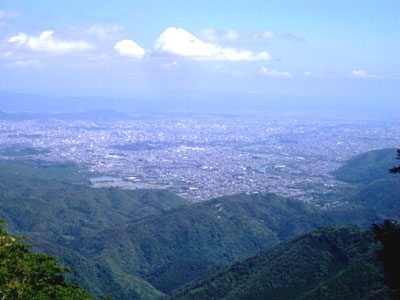 |
The hundred years which saw the fall of the Ashikaga
dynasty and the establishment of the Tokugawa—more precisely from 1543 to
1641—saw also the first period of contact between Japan and missionaries and
traders from the West. Among missionaries Francis Xavier and the Jesuits took
the lead; among traders the Portuguese. The Jesuits were followed by mendicant
friars, whose methods were less diplomatic; the rapid advance of Christianity
during the second half of the sixteenth century was checked before its close,
in the time of Hideyoshi, on political grounds. The
new creed appeared to be subversive of order, as, centuries before, it had
appeared to the Roman Marcus Aurelius. Jesuits and mendicant friars fell under
the same ban.
The trade initiated by the Portuguese, and after them
by the Spaniards, was taken up in the early years of the seventeenth century by
the Protestant English and Dutch, newly emancipated from the Spanish
domination. Will Adams, who sailed with a Dutch expedition, was the first Englishman
to reside in Japan (1600). On his arrival he found favour with Iyeyasu, for whom he built ships, and he remained attached to Japan till
his death in 1620. The Japanese reaped their profit, but their vigorous rulers
at this period were ill-pleased with the extensive slave trade for which all
the foreigners, but primarily the Portuguese, were responsible; they found the
dissensions between the European rivals unedifying, and the arrogance and
piratical violence of the Portuguese in particular intolerable. The English
were but in the background; the Dutch, as being Protestants, and at enmity with
the Hispano-Portuguese power (the two kingdoms Were at this time united under
one crown) were dissociated both from the offensive Portuguese and the
suspected Catholic missionaries. The climax was reached in the reign of Iyeyasu's successor. Foreigners and missionaries were
banished utterly from the country; only the Dutch were permitted to maintain a
trading establishment at Nagasaki. In spite of the embassy of the Dutch East
India Company in 1657, from whose record illustrations are here reproduced,
even that favoured nation was kept resolutely at
arm's length; for two hundred years the Japanese interior was jealously hidden
from the anarchical influences of the West.
Map of Japan drawn by William Adams, circa 1600
|
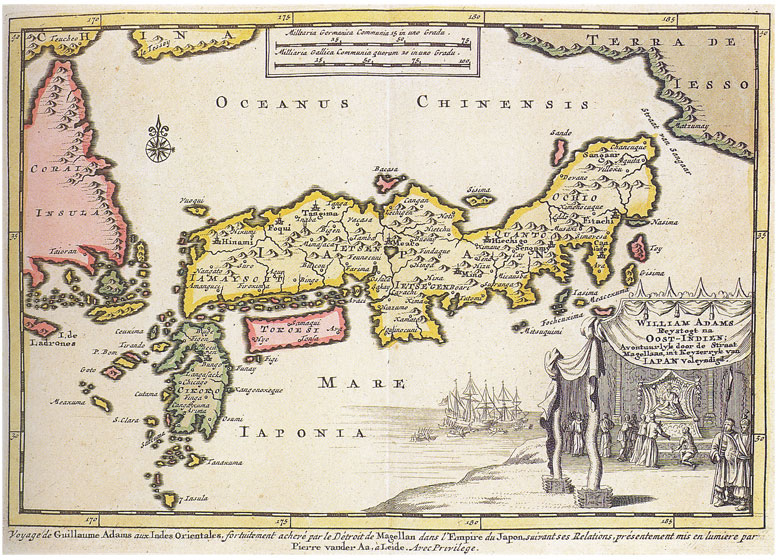 |
Feudalism in Japan is usually considered to have
originated in 1192, when Yoritomo the imperial civil governors (Kokushu), who had been previously drawn from the Court
nobility (Kugé); and replaced them by military
governors belonging to the Buké class.
The actual beginnings of this organisation must belong to that period toward the close of the ninth century when the
family holdings of the peasants (that is, the system of vassal tenure under taxation
created by the Taikwa reforms of the seventh century)
were replaced by the great estates, exempted from taxation, of the Shoyo and Denyo owners. The
former of these systems originated in grants of land to those by whom it had
been brought under cultivation, the latter in the arbitrary appropriation of
Government lands by the governors and their subordinate officials. From the
tenth to the twelfth century the Shoyos absorbed the
larger proportion of all the landed property; the country became the lreehold property of the occupants, who were independent of
the provincial governors and exempt from taxation.
These inhabitants were known, as territorial owners (Riyoshu) or owners of hereditary estates (Honjo); they usually lived in Kioto,
or upon their ancestral property and handed over the administration of their
estates to shoshi, or bailiffs. The territory Shogun
at an audience given to traders. He remained twenty years. These officials and
their subordinates, like the Kugé of Kioto, absorbed the peasant holdings, bought up the
properties held by families in common, and possessed themselves of the common
forests and meadows, which thus became private Denyo possessions. The right of administering justice was usually concurrent with
possession; the consequence was that not only the income of the emperors—that
is, of the Government—but also their judicial powers, were greatly restricted,
and what they lost the landowners gained.
During the following centuries, which were occupied by
continual civil War, this condition of affairs was naturally considerably
extended. Towards the end of the sixteenth century the whole country was in the
hands of great territorial lords who, whatever their position, had risen from
the military order, and to whom, instead of to the emperor, the peasants were
responsible for the payment of taxation and the performance of labour services. Where individuals of importance gained and
exercised high powers, the smaller owners within the boundaries of their
property, or within their sphere of influence, were dependent upon them.
Hence, at the outset of the seventeenth century two
lines of feudal relation had been formed : there was the theoretical relation
of the great owners to the helpless emperor, and the practical dependence of
the smaller owners upon their powerful overlords. Of the latter character was
the connection of the members of the Samurai (or knightly) class with their
lords, though here, again, a further subdivision existed, according as a
dependent was invested with the possession of land, or only received payment,
usually made in rice; he performed service according to his rank, either alone
or with a following of his adherents, either in the cavalry or as a
foot-soldier. Cavalry service in Japan, as in all feudal states, was considered
the more honourable, and carried with it the further
distinction of permission to ride on horseback in times of peace.
Such was the general condition of affairs when Iyeyasu
became powerful enough to establish the main features of his administration. In
general he introduced but few reforms, and contented himself with accommodating
the existing system to the necessities of his government, and with making
numerous changes in the possessions held by the territorial lords; he transferred
them from one province to another, according as he desired to reward or to
punish them, a change which carried with it diminution or increase of revenue.
Officials in immediate connection with the Empire were
alone excepted from this measure. Hideyoshi had
already cleared the way for these changes by his division of the landowners
into three classes: these were the Kokushu, the
owners of a province at least; the Riyoshu (landed
owners), in possession of land bringing in a yearly revenue of 100,000 koku or
more of rice (a koku = nearly five bushels); and the Yoshu (the owners of castles whose property brought in an annual income of less than
100,000 koku).
Territorial owners were known as Daimiyos (great name), a title which, however, properly belonged only to the first two
of these classes. The Kokushu became the military
governors of Yoritomo; after the fall of the Hojo family (about 1333), the title of Kokushu, formerly
appropriated to the civil governors, had been assumed by them, though their
relation to the emperor had been in no way altered by the change. When for a
short period the government returned to the hands of the emperor and the Kugé, the friendly treatment meted out to this class was of
an illusory nature, possessing no practical value.
Iyeyasu added two classes, the Hatamoto (Under the Flag) and the Gokenin to the three already
existing. The Hatamoto, who numbered apparently two
thousand, possessed different positions and incomes, some being small
landowners while others were paid yearly incomes in rice by the Shogun; of the
former, seven were placed upon an equality with the Daimiyos,
in so far as they were obliged to reside alternately in Yedo and upon their property, whereas all the others were forced to remain
permanently in Yedo. The Gokenin,
about five thousand in number, received a small salary, and were employed to
fill low official posts under the Shogun. Next in order to these came the
ordinary Samurai.
Very similar was the condition of the larger
territorial owners, since they also had a number of vassals in direct
dependence upon them. Generally speaking, the organisation of these private vassal-trains was as follows : In the first place, the Karo
(elders), who often bore the title of Minister, were almost invariably in
possession of land within the district of their lords, who could summon them
with their contingents to war.In the case of certain
territorial owners, Iyeyasu seems to have appointed elders, and to have sent
them into their territory, apparently with the object of thus keeping watch
upon the lords and bringing pressure to bear upon them in case of necessity.
The Samurai were either in possession of land or received an income of rice,
the former of the two positions being the more highly esteemed. They usually
dwelt under the prince's roof, or in close proximity to his castle.
Many of these territorial owners, upon their
transference to other districts, were unable to take with them a large
proportion of their adherents, but they often found numerous Samurai on the
spot who had lost their former lord or had been unable to depart with him. From
these people (Goshi) a kind of yeomanry was formed,
the eldest son of a family inheriting the name, rank, and property of his
father, while the other children remained upon the level of the common folk.
The Goshi was allowed to sell his name, his position,
or his land, with the permission of the overlord. If he sold only a portion of
the latter, he retained his name and his rank; he lost both upon the sale of
his whole property. The Goshi were allowed to possess
horses, and were often people of influence and position; the common peasants
were their servants. Upon the restoration of the Mikado, in 1868, the Goshi alone retained their landed property, since it was
assumed that they had not received it from the Tokugawa, but had been in
occupation from the remotest times. Intermediate between the Samurai and the
common peasants were the Kukaku, a kind of country
gentry who received a yearly income of rice and wore two swords, were not
allowed to ride, and lived on the borders of the capital or in the country.
The peasants paid their taxes to their overlord, the
Karo, or the Samurai, to whom their land had been assigned, but he was not
obliged to transmit such payments to the territorial owner. The peasants do not
seem to have been absolutely in the condition of serfdom. In cases of gross
idleness they could be removed from their property, which they could also sell
under certain conditions; in time of war they served only as labourers or carriers. The unit of peasant society was the
village, or mura, which usually consisted of fifty
men (families), divided into ten groups of five members. Taxes were neither
assessed upon nor paid by individuals; a fixed amount was debited against the
village, and the inhabitants were collectively liable. Every peasant possessed
his own house and arable land; but pastures and grazing lands were common property,
while forest and moorland belonged in most cases to the overlord.
When Iyeyasu took up the government eighteen Kokushu were in existence. In due course these were
increased by the two princes of Kii and Owari, thirty-two Riyoshu, and
two hundred and twelve Yoshu. He introduced, however,
another division of the territorial owners. There were seventy-five outside
nobility (Tozama) appointed on an equality with the
princes, apparently the earlier of the Crown officials. All others were
entitled Fudai—for a long period a term of courtesy,
or with the meaning, "vassals of the dynasty"; they were invested
with their possessions by the Shogun, and were allowed, or probably obliged, to
take up positions under Government. For this system of division Iyeyasu himself
gave as a reason that the Fudai were the class of
owners who had supported him before the capture of the castle of Osaka in 1603,
while the Tozama had only submitted to him at a later
period.
THE FORTRESS OF OSAKA, A FORTRESS OF VAST IMPORTANCE
IN JAPANESE HISTORY
Osaka was a strongly fortified possession of the
princes whose forces lyeyasu attacked in 1600. It was
the key to the capital, Kioto, and its fall,
following on the battle near Lake Biwa, established the triumph of Iyeyasu as Shugun.
|
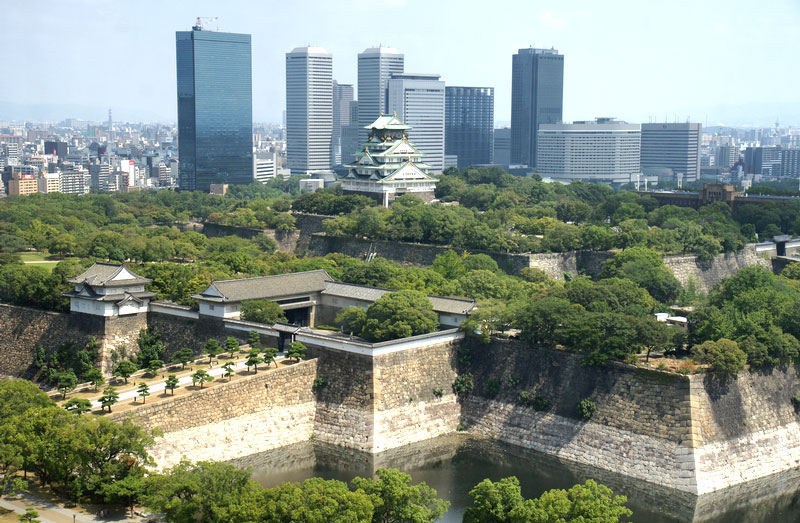 |
Of still greater importance was the distribution of
the territorial owners, the Hatamoto and the
officials, into councils, in which they deliberated apart when summoned by the
Shogun.
These councils were summoned when any important
questions arose. They arrived at their decisions in isolation by a majority of
votes, and the question at issue was ultimately decided by the vote of the
majority of the councils. Current business was transacted by committees
composed of such members of individual councils as were present in Yedo. The relations of the Mikado and the Kugé to the empire were so arranged that while they
retained all their titles and prerogatives, they lost every vestige of
influence and power. The income of the Imperial Court and of the Kugé was reduced as much as possible, and they were almost
entirely excluded from connection with the outer world. One hundred and
thirty-seven Kugé with, amongst them, five titles of
the second class, and 27 of the third class, had a yearly income of about
42,500 koku of rice (a koku equals five bushels), whereas 263 Buké, including the Shogun, though possessing only one
title of the second and four of the third class, had a yearly income of
30,000,000 koku. The revenue of the Imperial Court was established in 1615 at
10,000 koku, and gradually increased to 120,000 koku by the year 1706. In 1632
the yearly incomes of all territorial lords amounted to 18,700,000 koku, while
the income of the Shogun's house, derived from its immediate property, amounted
to 11,000,000 koku.
Iyeyasu issued several proclamations, particularly the
so-called "Eighteen Laws" and "One Hundred Laws", the first
of which ideals particularly with the relations of the Shogun to the Imperial
Court, and the latter with those of the Shogun to the territorial lords, the
Samurai, and the people. These manifestoes explained that the larger incomes of
the Buké class carried with them the obligation of
greater services to the State, whereas the Kugé were
allowed to expend their smaller revenues exclusively upon themselves. Beyond
this the Buké were obliged to provide cavalry in
proportion to one- half of their revenue, at the rate of five men to every
1,000 koku, so that a lord with a total income of 200,000 koku provided 500
cavalry in case of war.
To understand the Japanese constitution at this time
is only possible when we take into account the theory on which Iyeyasu defended
the virtual deposition of the Emperor and of the Kugé,
and the transference of the power to the Shogun and Buké.
It will be helpful to an understanding of Iyeyasu's time and policy to give extracts from his Laws.
"According to an old doctrine of the country of
the gods [Japan], the gods are the genii of heaven, as the Emperors are of the
earth. The genii of heaven and of the earth can be compared with the sun and
the moon. And for the same reason that the sun and the moon fulfil their
course, so must the Emperor keep his noble heart unharmed. For that reason, he
lives in his palace as in heaven; indeed, corresponding to the nine heavens,
the palace contains nine sets of rooms with 12 gates and 80 chambers; moreover,
his insignia are the ten virtues, and he is lord of 10,000 chariots—[in China
the Emperor marched out to war with 10,000 chariots]. Every day he is to pray
to heaven that he be an example to the country in philanthropy, filial piety,
intelligence, and economy; he shall also be assiduous in the practice of
learning and the art of writing. By such means the lofty virtue of the Emperor
is spread abroad, so that the faces of his subjects be not overspread with the colour of grief, and peace and happiness rule everywhere
within the four wall" (Eighteen Laws: 1)
"As the office of overseer of the two Court
schools in Kioto has been transferred to the Shogun,
the three Shinno [Imperial Princes], the Shike [families in which the highest dignities were
hereditary], the Kugé and the territorial lords, are
collectively subordinate to him. By his orders he regulates all duties owed to
the State, and in State questions he may act without the Emperor's assent. If
the country between the Four Seas is not at peace, then the Shogun shall bear
the blame." (From the Eighteen Laws : 2)
A DAIMIYO IN COURT DRESS |
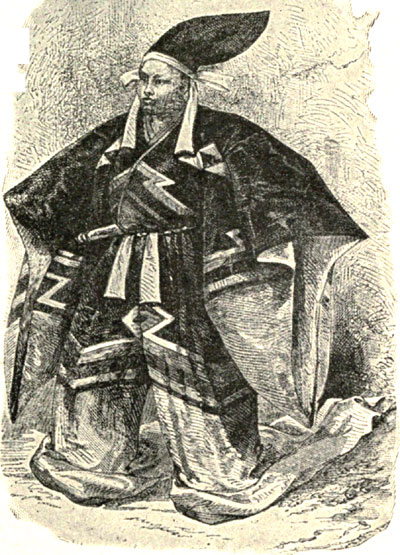 |
"In ancient times the Emperor was wont to make
pilgrimages to different temples, and this in order that he might become
acquainted with the sorrows of his people upon the way. Now, however, the
emperor has reformed the Government, and entrusted it to the Buké. If these be unaware of the miseries of the people,
the Shogun shall bear the blame. Therefore the ruling Emperor shall no longer
leave his own palace, except when he betakes himself to visit in his palace the
Emperor who has abdicated." (From the Eighteen Laws : 4)
"With Minamoto no-Yoritomo, who governed as Hao
[literally the helper of the Emperor], the supremacy of Japan has passed into
the hands of the Buké. As the Kugé carried on the government carelessly, and were unable to maintain order in the
country, all that could be done was for the Emperor to order the Buké to take over the ancient government. But with
inadequate revenues it is impossible to govern a country, to feed the people,
and to perform the public services. Thus the Kugé would commit a great wrong should they seek to detract from the Buké. According to the old saying, 'All the country under
heaven belongs to the Emperor', the Emperor has been ordered by heaven to feed
and to educate the people; for this reason he orders officials and warriors to
care for the peace and prosperity of the country. It would have been possible
to entrust the Kugé with the performance of this
office; as, however, this arrangement is displeasing to the people, the Emperor
has given it to the Buké. If the land be not at rest,
differences of rank between high and low disappear, and uproar is the
consequence, therefore the Buké shall conscientiously
perform the duties of their office." (From the Eighteen Laws: 15)
"If the five harvests do not come to maturity,
then is the government of the Tenshi [the Son of
Heaven, the Emperor] bad; but if many punishments must be inflicted throughout
the realm, then ye are to know that the military powers of the Shogun are
inadequate. In either case ye (my successors) shall make tried of yourselves to
that end, and be not careless." (One Hundred Laws: 89)
Originally the position of the Shogun compared with
that of the Kokushu Daimiyo was little more than that of "first among equals"; it was only by
degrees that he assumed the dominant position. The Kokushu were originally exempt from the rule compelling the landed nobility to spend a
year in Yedo and a year upon their properties
alternately, their families be ng obliged to remain permanently in Yedo; but under the third Shogun the Kokushu were in this respect treated like the smaller princes. The only prerogative
they possessed was, that as theoretical vassals of the Mikado they were Crown
officials, and received their investiture at his hands.
However, they could only approach the Mikado through
the Shogun, who superintended the confirmation of titles upon the territorial
lords by the emperor. Any direct communication between the Imperial Court and
the territorial lords was strictly forbidden. Even when travelling from their
districts to Yedo or back, they were not allowed to
pass through Kioto; if they desired to visit the
Imperial capital or its suburbs, they were required to obtain a special permit
from the Shogun, and even then they were not allowed to approach within a
certain distance of the Emperor's palace. For a marriage between a member of a Buké family and one of a Kugé family, the express permission of the Shogun was equally necessary. To become a
medium for the transmission of gossip upon political affairs to the Imperial
Court was to commit a crime punishable with the utmost severity.
In other respects all possible measures were taken to
keep the territorial lords in a state of dependence. Upon the redistribution of
districts friends and former foes were so intermingled that the former could
keep an eye upon the latter, and, apart from this, the property of the Shogun
was scattered throughout the country in such a manner as to enable him to visit
other districts without trouble. Strong garrisons were kept up in Kioto and Fushimi, as also in several districts of the
province of Suruga; all the passes leading to the Kwanto were provided with guards, and the chief trading and commercial centres (such as Osaka, Sakai, Nagasaki, 18 in number) were
in the power of the Shogun.
ANCIENT CHIEF OF A CLAN |
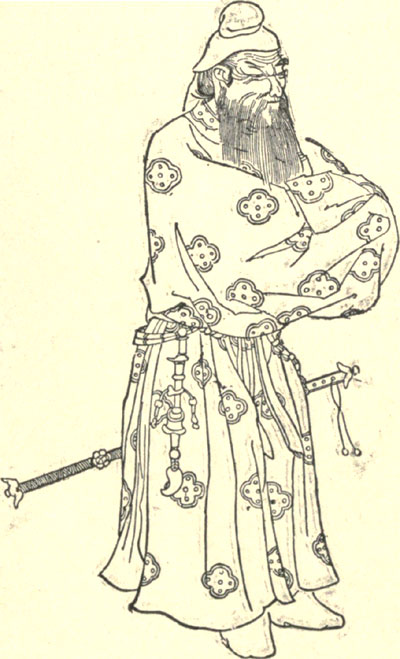 |
His officials now undertook those tours of inspection
upon which the emissaries of the Mikado had previously been sent every five or
seven years, and in cases where the high position of the territorial lords,
such as the Kokushu, made this kind of supervision
impossible, friends and presumable enemies were entrusted with the task of
keeping guard upon one another. Thus, for instance, the defence of the island of Kyushu was entrusted to Satsuma and his opponents, Hizen, who relieved one another every year. Moreover, the
whole country was covered with a network of officials and spies of the Baku-fu
bureaucracy. Thus Iyeyasu and his successors made every possible effort to keep
the territorial lords within bounds. The system eventually collapsed, not so
much before foreign attacks, as because those classes whom its founder had
specially designed to be its supporters first undermined and then overthrew it.
The Shogunate fell because it was abandoned by those who should have had the
greatest possible interest in ensuring its permanence.
If the regulation of the position of the Emperor, the Kugé, and the territorial lords had been difficult, a yet
more arduous task confronted the founder of the Tokugawa dynasty of Shoguns
when he came to grapple with the settlement of questions of family precedence
and of the succession. Iyeyasu left five sons, the princes of Echizen, Kii, Owari, Mito, and the second
son, Hidetada, whom he had appointed as his successor during his lifetime, and
invested with the power. He arranged that the succession should follow the
direct line of Hidetada's family, and that if no heir should be forthcoming one
should be chosen from the house of Kii, or that of Owari. These houses, and that of Hidetada, were entitled
Three August Families (Go-san-ké),
as being the three most important houses. At a later period the title was also extended
to include the houses of Kii, Owari,
and Mito, though it did not in this case imply the possession of claims to the
succession.
On the other hand, the prince of Mito obtained the
right of demanding or proclaiming in certain cases the deposition of a Shogun
who had not performed the duties of his office, while under other conditions
the position of regent was reserved to the prince of Echizen. The prince of
Mito was also the only territorial lord who possessed the right of direct
communication with the emperor. Echizen the eldest son, and Mito, the youngest,
were excluded from the succession; the first had been originally adopted by Hideyoshi, and had thus ceased to belong to his father's
family according to Japanese ideas, while the latter had married the daughter
of a former enemy. Iyeyasu himself is said to have characterised his son the lord of Mito as a very important, but extremely dangerous
personality, and to have compared him to a sharp sword, which is only harmless
so long as it remains in the sheath. Two hundred and fifty years later the
foresight of the founder of this dynasty was to be confirmed : in any case, the
house of Mito materially contributed to bring about the downfall of the
Shogunate.
The question of the succession, already sufficiently
difficult, became still further complicated by the fact that in 1715 the family
of Hidetada became extinct in the direct line. The prince of Kii, who had been appointed Shogun, hastened to invest his
second, third, and fourth sons with the titles of princes of Taiasu, Shimizu, and Hitotsubashi;
he then arranged that these three families, to whom he gave the common title
the Three Lords (Go-san-kio),
should provide a successor in the event of his first son's descendants becoming
extinct in the direct line. This regulation also proved ineffectual. A younger
son of the house of Mito, Kei-ki, who had been adopted by a prince of Hitotsubashi, was appointed Shogun in 1866; the last of a
long line, his loss of the supremacy in no way redounded to his honour.
Iyeyasu died at his castle of Sumpu,
in Suruga, on March 8th, 1616, and, according to his wish, was buried a year
later in Nikko, a mountainous district, richly wooded and adorned with every
kind of natural beauty, about ninety miles north of Yedo,
where Buddhist and Shinto temples, erected by the holy Shodo Shonin, had existed since the close of the eighth century. A representative of
the Mikado and of the Shogun, together with a great number of the Kugé, the territorial lords, and their military comrades,
were present at the burial of the deceased, upon whom the Mikado conferred a
special title of honour to mark the occasion. The
dead man was created "Noble of the First Class, of the First Rank, Great
Light of the East, Great Incarnation of Buddha". After the death of the
former abbot and the abdication of his successor, Go-Mizuno, the fifth son of
the Mikado was appointed high-priest of Nikko, in the year 1634, under the
title of Rinnoji-no-Miya. He and his successors, who
were afterwards princes of the Imperial House, usually resided at Yedo, in the temple of Uyeno, and
visited Nikko three times a year.
The last of these Imperial priests, Kita Shirakawa
no-Miya, who was afterwards educated in Germany, was abducted by the northern
party during the civil war of 1868, and set up by them as an opposition Mikado,
but shortly afterward yielded to the attacks of the victorious southerners. Of
the successors of Iyeyasu, one only, his grandson, Iyemitsu (1623 to 1651), was buried at Nikko. All the other Shoguns were buried at Yedo, either within the precincts of the temple of Uyeno or within that of Shiba. The temples of Nikko are
certainly the largest, the richest, and most beautiful in Japan, and are
distinguished by the artistic finish of the buildings and the decorations of
their interior, as well as by the beauty of the surrounding landscape. The
interest of the spot and of its buildings is further increased by the numerous
dedicatory presents in and about it, brought from every part of Japan, and even
from Holland.
Hidetada, the first successor of Iyeyasu, followed in
his father's footsteps, and maintained the institutions introduced by him. Iyemitsu, the grandson of the founder of the dynasty, was
undoubtedly the most important of the fourteen Shoguns who followed Iyeyasu. He
laid a stronger hand upon the reins of government, obliged the great landowners
to render a formal recognition of his undisputed supremacy, and made himself
and his successors masters of Japan.
The visit which he paid to the Mikado in Kioto, in 1623, was the last paid by any Shogun until the
year 1863. It was under his rule, in 1641, that the Dutch and the Chinese were
sent to Nagasaki, and all other foreigners were expelled from the country,
while emigration and foreign den to the Japanese, the weights and measures were
reduced to a common standard, the delimitation of the provincial frontiers was
begun and completed, maps and plans of the districts and castles belonging to
the territorial lords were made, the genealogical trees of these latter were
drawn up, and all names obliterated which might have aroused disagreeable
political recollections or have given rise to inconvenient claims. Moreover,
the two State councils, the upper and the lower chambers, werere organised. Finally, Iyemitsu made his capita of Yedo not only the most beautiful
but also the most cleanly and the best fortified city in the kingdom. The
castle, with its triple line of walls and moats, was then considered
impregnable, and even today rouses the admiration of the visitor. Iyemitsu was also the first to employ the title of Great
Lord (Taikun), as the expression of his absolute
power in his intercourse with other countries, such as Korea.
Of his successors we need only mention Yoshimune (1716-1745), the last of the direct descendants
of Iyeyasu. He gave much attention to the improvement of agriculture and
manufactures, and repealed the prohibition of the introduction of European
books, though this still held good of such as dealt with the Christian
religion. Of his remaining successors it need only be said that they confined
their actions, generally speaking, to the lines already laid down. However,
their power of independent action was completely destroyed by the bureaucracy,
which took into its hands more and more of the administration. Government
departments degenerated in consequence, and the fall of the Shogunate was the
ultimate result.
| YEDO, THE ORIGINAL TOKIO. THE SHOGUN'S CAPITAL, IN THE
TIME OF IYEYASU, ABOUT 1600
|
 |
Earthquake in Yedo (Tokyo)
in 1659, illustration from the account by Arnold Montanus of embassies sent by the Dutch East India Company to the Emperor of Japan,
published in Amsterdam 1669
|
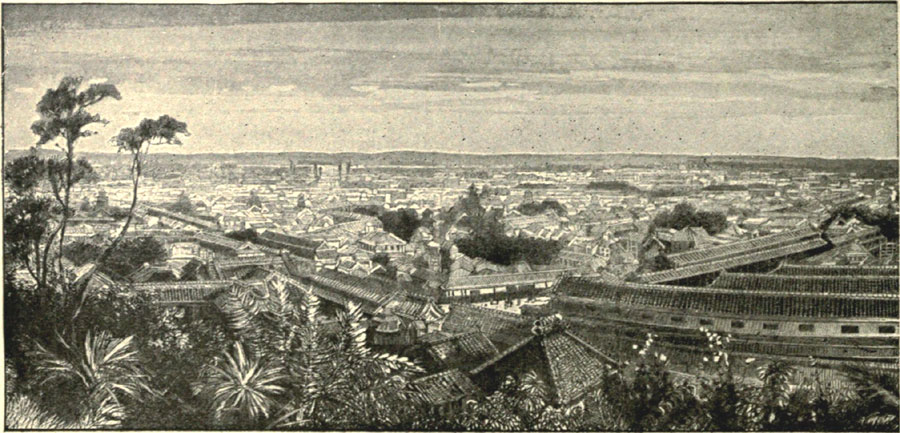 |
A DAIMIYO'S COURT AS PICTURED BY A DUTCH ARTIST IN THE
SEVENTEENTH CENTURY
|
THE TOWN HOUSE OF A DAIMIYO IN OLD TOKIO
|
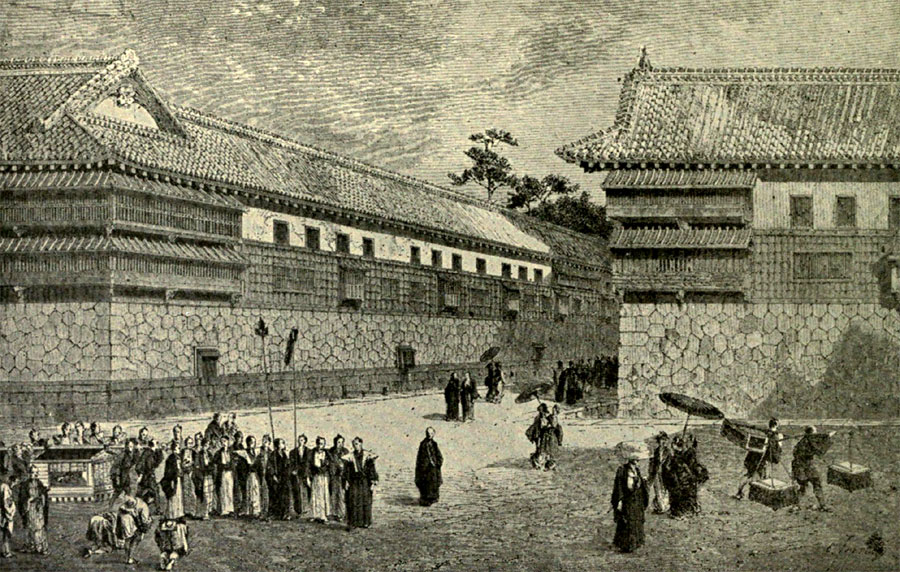 |
THE PALACE OF THE SHOGUN OF JAPAN AT YEDO
|
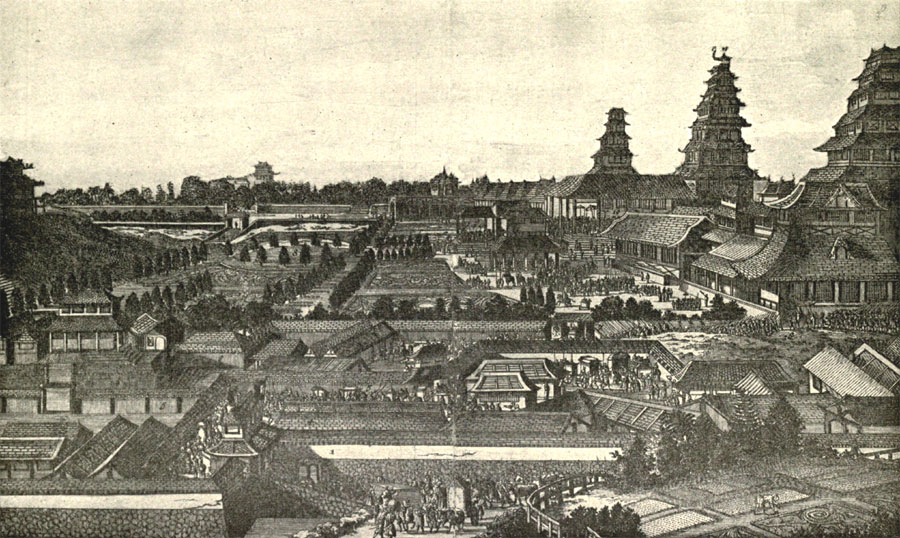 |
THE COURT OF TWE SHOGUN OF JAPAN AS PICTURED BY A
TRAVELER OF THE SEVENTEENTH CENTURY
|
 |
In his work upon the social and economic development
of Japan, Tokuzo Fukuda defines the rule of the
Tokugawa as a period in which the Government was that of a policeman with
unlimited powers. This statement, however, is true only of the second half of
the government of the Shogunate, and of that only in so far as the
administration was careful to maintain existing institutions and to throw
obstacles in the way of all innovations, which the bureaucracy in Japan, as
everywhere, considered as so many threats against the existence of the State.
The heaviest oppression has never been more than a temporary obstacle to
national development; and so in Japan under the Shogunate, development, far
from coming to a standstill, followed a roundabout course, and society advanced
by devious paths from the old order to the new. The most obvious confirmation
of this fact is the part played by the towns, or, more correctly, by the
mercantile class of community.
The vigorous rule of the first Shogun, and especially
of the third, convinced the territorial lords that the dynasty of the Tokugawa
was entirely capable of maintaining its supremacy, and that any attacks upon it
would recoil upon the heads of their promoters. At the same time the measures
of the Shogunate, especially those respecting the hereditary rights of the
great families, inspired the conviction that the existence of the territorial
nobility, so far from being endangered, was secured even more permanently than
before. The great nobles were therefore able to concentrate their attention
upon the peaceful development of their districts. The ordinary Samurai were in
a far more evil case, especially in the matter of their yearly salary of rice.
Their business was war, and any other occupation was forbidden to them. As,
however, their salaries were usually inadequate for their support, the
consequence was that in course of time a large proportion of the Samurai became
deeply involved in debt. They were then obliged either to lay aside their
swords, renounce their profession and enter some other, or, while retaining
their swords, to leave the service of their overlord and to join the class of
the Ronin, the masterless Samurai, who were the terror not only of the peaceful
citizens, but also of the Government.
As regards the peasants, the position of those settled
upon the land of the Shogun was, upon the whole, preferable to the lot of those
within the districts of the territorial lords. While the former were treated
with kindness and consideration, the latter were without defence against the extortions of the officials of their prince. The average holding of
a peasant was small; the least quantity of land amounted to about two and a
half acres, and was but seldom increased; consequently their agriculture was
rather of the character of market gardening.
Fukuda asserts that the towns had developed from and
around the castles of the territorial lords, for the reason that the formation
of towns in Japan dates from the period of war after the twelfth century. The
statement is correct only from one point of view. In a state which had already
existed for a thousand years men and houses must have collected in large
numbers at the most important points upon the several lines of communication.
Naturally the new territorial lords would choose such
positions for the central points of their districts, and would settle and erect
their fortified castles in them; not less naturally the inhabitants would
gather more closely round the protecting castles, and possibly in the course of
time two or three villages may thus have been united into one community. At any
rate, the towns of early Japan never attained any power of self-government;
they were not even considered as independent communities, and the period of
their growth and prosperity begins, in almost every case, at the time following
the rule of Iyeyasu. Centuries of civil war by no means favored the increase of
merchants and handicraftsmen, and of these the population of the towns was
chiefly composed. The system of caste which prevailed in Japan must also have
hindered commercial development. The warrior caste was the first; with it, if
not theoretically at any rate in practice, were joined the castes of scholars,
physicians, artists, priests, and others; then came the farmers, then the
handicraftsmen, and finally the merchants. Below these were the dishonorable
castes— actors, jugglers, dancing women, etc., and the unclean castes—
knackers, tanners, executioners, and so on.
Gaiety In a Riverside Tea House, 18th century Edo Period |
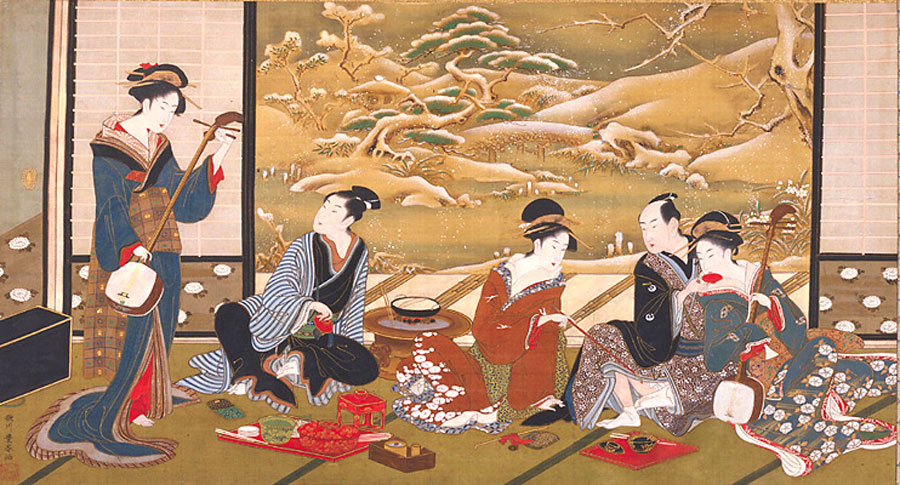 |
After their rise the towns lay either on the demesne
of the landed lords, upon whose whims and ideas their growth materially
depended, or on the demesne of the Shogun, who had succeeded in getting
possession of the most important trading centres—Yedo, Osaka, Kanagawa, Nagasaki, Sakai, Hakodate, and Nigata near Yokohama. Hence the Shogunate was obliged to
confront the task of extending trade and procuring the recognition of the
traders' importance. Even during the period of foreign influx the Shoguns had
made every effort to secure to themselves the largest possible share of the
profits derived from commercial intercourse with other lands, and this object
they entirely attained when they removed the Dutch and the Chinese to Nagasaki.
At the same time exports and imports were so regulated in amount that the
balance of trade might be as much as possible in favour of Japan.
Foreign wares were sold at so high a price as to be
within the reach of only the richest classes, while the exportation of anything
that the country wanted, or seemed to want, was restricted or prohibited
entirely. Thus in 1752 the exportation of gold, which had previously been
subject to repeated restrictions, was entirely forbidden; in 1685 the
exportation of silver, which had been employed to pay for the imports, was
limited to 2,000 lb., an amount further reduced to 500 lb. in 1790; in 1685
exports of copper were limited to about one ton; from 1715 onward only Dutch
ships were allowed to visit Japan in any one year, and from 1790 only one.
Communication with the Chinese was limited in a similar manner.
On the other hand, every effort was made to provide
facilities for internal trade, especially after the year 1694, when guilds (kumi) were created in Osaka and Yedo,
at first ten in each town, a number afterwards increased to twenty during the
years 1720 to 1730. These were free societies, occupied with mercantile and
shipping business, and seem to have been chiefly active in promoting the sale
of the manufactures produced on the demesnes of the territorial lords.
Consequently an unusually severe blow was dealt at their existence in the
middle of the eighteenth century, when the lords demanded and obtained the
permission to sell their products at the great commercial centres by means of their own merchants.
Possibly it was this regulation which induced the
Government in 1813 to place the guilds upon another footing. They now became
close corporations of merchants and manufacturers; their number and the numbers
of their members were defined by law. They were not allowed to elect new
members, but upon the death of an individual could admit only his blood
relations, and they held the monopoly of the sale of that particular article
with which they were concerned. In 1841 this arrangement was abolished, after
many complaints had been made of the manner in which prices had been forced up;
but it was reintroduced in 1851, apparently because the Government thought they
could not dispense with the general supervision exercised by the guilds.
In other respects, during the rule of the Tokugawa,
conditions remained practically unaltered. Ancestor worship continued, as did
the patriarchal system, and the responsibility of the patriarch for the actions
of members of the family. The law of inheritance, which gave a disproportionately
favored position to the eldest son, remained unaltered. The majority of posts
in the service of the Shoguns and of the territorial lords continued to be
hereditary. Custom demanded that a son should succeed to the profession or the
handicraft of his father. It was extraordinarily difficult to pass from one
class to another. All these restrictions must have constituted so many
obstacles to the free development of the individual, and consequently to the
progress of society.
A SHOGUN OFFICIAL IN COURT DRESS |
 |
Soon after the Shogunate had passed to the Tokugawa, a
certain opposition began to arise within this family itself to the policy of
usurpation by which the Mikado had been deprived of his rights. This movement
remained for a long period exclusively literary, and its chief representatives
and supporters were to be found among the princes of the house of Mito.
The early history of this house is a good example of
the manner in which the fortunes of the landed nobility changed during the age
preceding the definite pacification of the kingdom. The territory afterwards
included in this principality was governed from the tenth century by scions of
the Taira family. It was overcome in 1427 by Yedo Michifusa, who was the first to assume the name of Mito. In
the year 1590 the Yedo family were driven out by the Satake. Yoshinobu, a member of the latter house, who had
joined the side of Hideyori, was transferred to
Akita by Iyeyasu in 1602. The fifth son of Iyeyasu was appointed Prince of Mito
in his stead ; when he died, upon the journey to Mito, the tenth son took up
the position. He was afterward transferred to Suruga in 1609, but became Prince
of Kii about ten years later, and was then succeeded
by the eleventh son, Yorifusa, who was born in 1603.
Yorifusa died in 1661, and was succeeded by his second son, Mitsukuni. He invited learned men to his Court, among them
apparently a number of Chinese who had fled to Japan before the Manchus, and
with their help he published, among other works, a "History of Great
Japan" (Dai-nihon-shi),
from Jimmu Tenno as far as the year 1393, in 240
volumes.
This is still considered as a work of capital
importance for students of Japanese history. He also published the "Reigiruiten", concerning the ceremonies of the Imperial
Court, in 510 volumes.
These works and a large collection of Chinese and
Japanese books, to which the prince continued to make additions until his death
(1700), largely contributed to direct the attention of scholars to early
Japanese history; hence Mitsukuni is justly
considered as the founder and promoter of the movement which is usually characterised as a revival of the pure Shinto teaching, and
undoubtedly exerted a powerful influence in preparing the way for the
restoration of the Mikados. The men who were chiefly influential
in their work in this direction were Kada (d. 1736), Mabushi (d. 1769), and Motoori (d. 1801). The latter published the Kojikiden, being
explanations of the Kojiki, a work attracting the
greatest attention, not only among scholars, but also and particularly among
the landed nobility. The "Great History" was continued by the princes
of Mito, and printed in 1851 after a long period of circulation in manuscript.
The successors of Mitsukuni, besides being patrons of
literature, were also sound and economical administrators of their territory,
so that the princes of Mito acquired a reputation as excellent rulers in
contrast to the Shogun. In 1829 Nariakira, the
brother of his predecessor, Narinaga, became prince;
he was destined to play a leading part in the struggle against the Shogunate.
The increasing poverty of the Samurai, the growing
degeneracy of the Shogun's Government, due to the rise of a bureaucracy, the
rapid spread of foreign ideas and the concurrent diminution in the power of the
Shogun, together with the more ardent desire of the territorial lords for
partial or complete independence—these influences found expression in the
formation of parties at the Imperial Court as well as at the Court of the
Shogun.
The situation became even more strained as the
repeated appearance of foreign vessels off the Japanese coasts—the first of
these visitors being the Russian squadron off Yezo in
1792—increased the fears of a hostile attack.
When apprehensions of this nature drove the Government
of the Shogun, in 1842, to request the landed nobility to take measures for
coast defence, the only response This pictured was a
general outcry occasioned by the shortness of money and the need for
assistance.
The very lords whose ancestors owed their rise to
power to the founder of the Tokugawa line deserted the Shogunate in its
extremity. The institution had become effete; it had to go, and it went,
"unwept, unhonored and unsung", in 1868.
With it went the greater part of the system of government that had obtained for
so many generations in the empire of Old Japan.
JAPAN AT PLAY: SCENE IN A THEATRE DURING A PERFORMANCE |
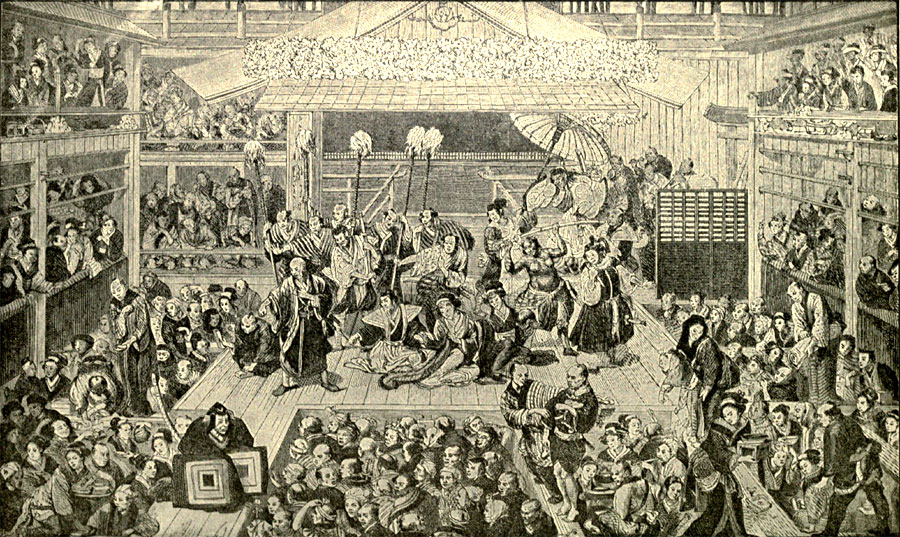 |
JUSTICE BEFORE THE GREAT CHANGE: A LAW COURT SCENE IN OLD JAPAN |
|
MUTSU-HITO. 123rd SOVEREIGN OF AN UNBROKEN LINE, FIRST EMPEROR OF NEW JAPAN |
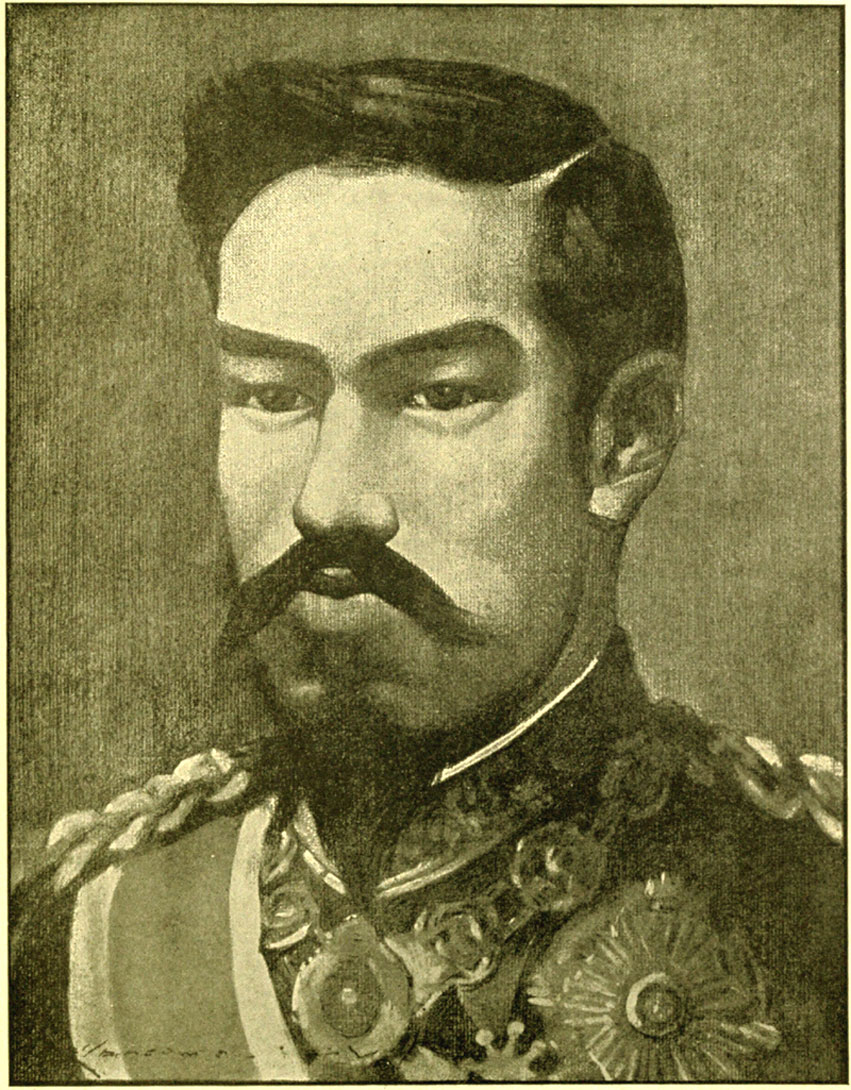 |
GOVERNMENT OF OLD JAPAN : THE COURT OF THE SHOGUN BEFORE THE RESTORATION OF THE MIKADOS |
 |
THE GOVERMENT OF IMPERIAL JAPAN : THE PRIMER MINISTER HANDING THE EMPEROR HIS SPEECH AT THE OPENING OF PARLIAMENT |
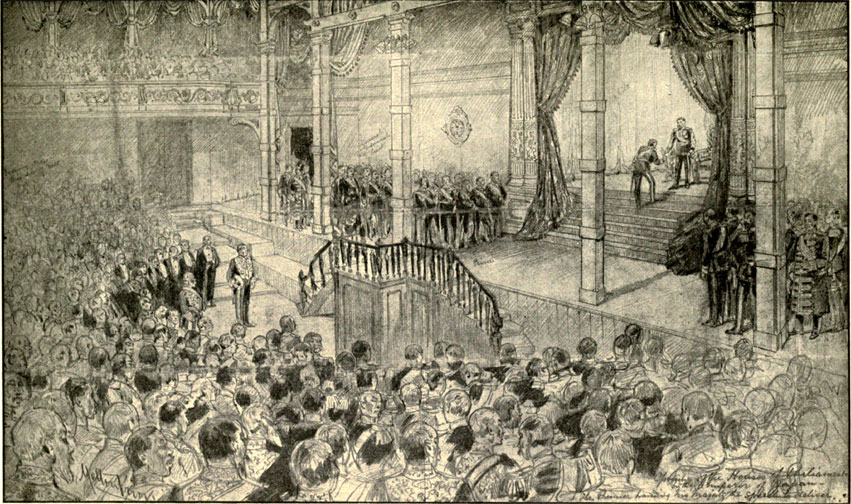 |
A WARSHIP OF THE SHOGUN ABOUT THE YEAR 1850. FROM A JAPANESE DRAWING |
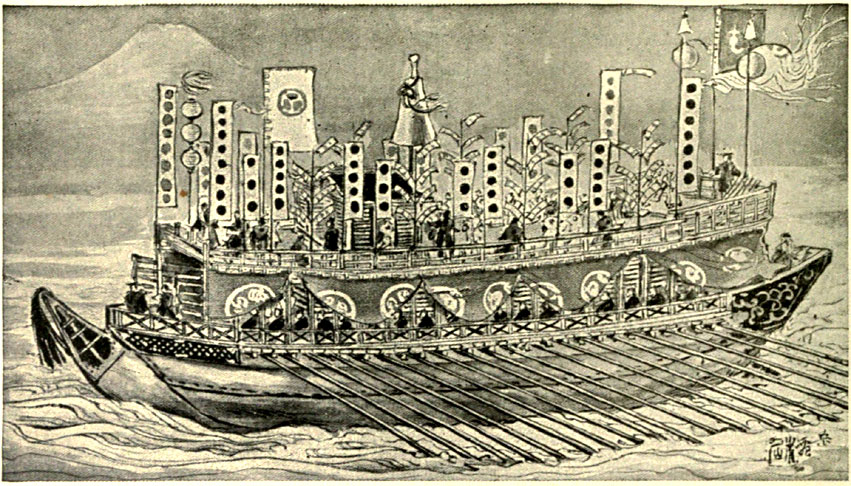 |
MODERN BATTLESHIP "SHIKISHIMA" REFLOATED AFTER BEING SUNK BY EXPLOSION |
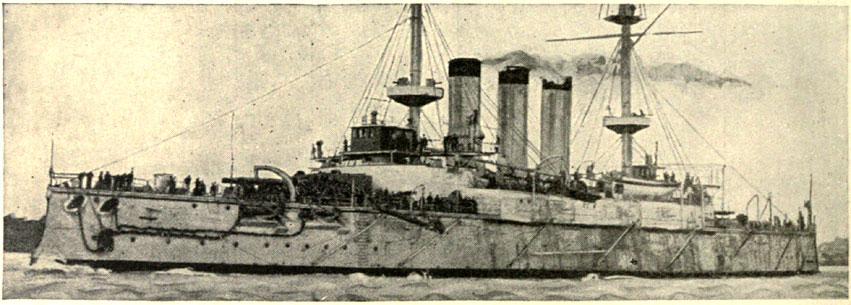 |
FIRST
BATTLESHIP BUILT IN JAPAN: THE "SATSUMA" IN YOKOSUKA DOCKYARD THE
REMARKABLE DEVELOPMENT OF THE JAPANESE NAVY
|
 |
WARRIORS OF OLD JAPAN : THOUSANDS WERE DRESSED LIKE THIS UNTIL 1868 |
|
THE REMARKABLE DEVELOPMENT OF THE JAPANESE ARMY |
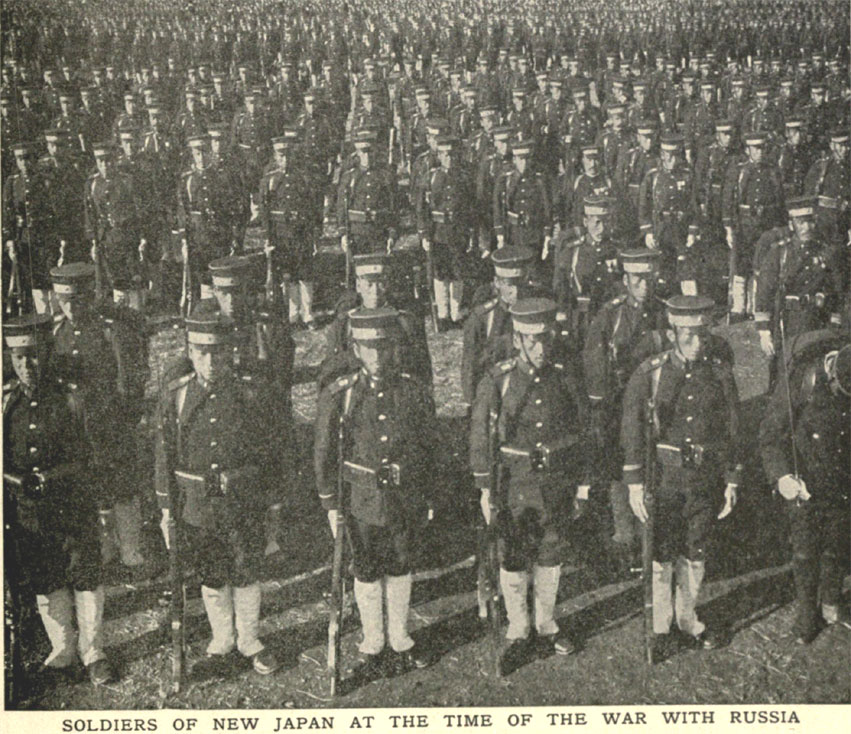 |
THE DOCTOR IN OLD JAPAN: A MEDICAL MAN ATTENDING A PATIENT |
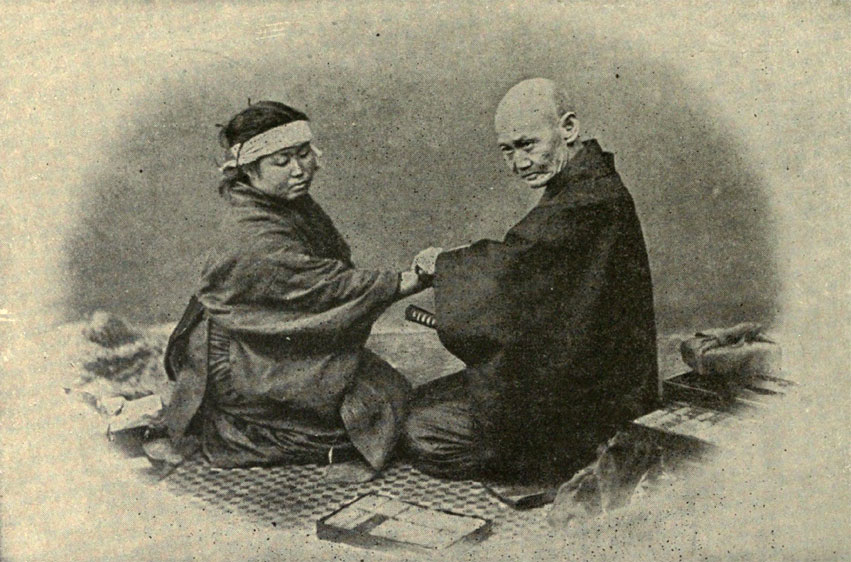 |
IN A WAR HOSPITAL IN 1905, WITH EVERY EQUIPMENT OF MEDICAL SCIENCE. THE STRIKING PROGRESS OF SCIENCE IN MODERN JAPAN |
 |
THE PRIMITIVE MANNER OF THRESHING RICE STILL LARGELY IN USE IN JAPAN |
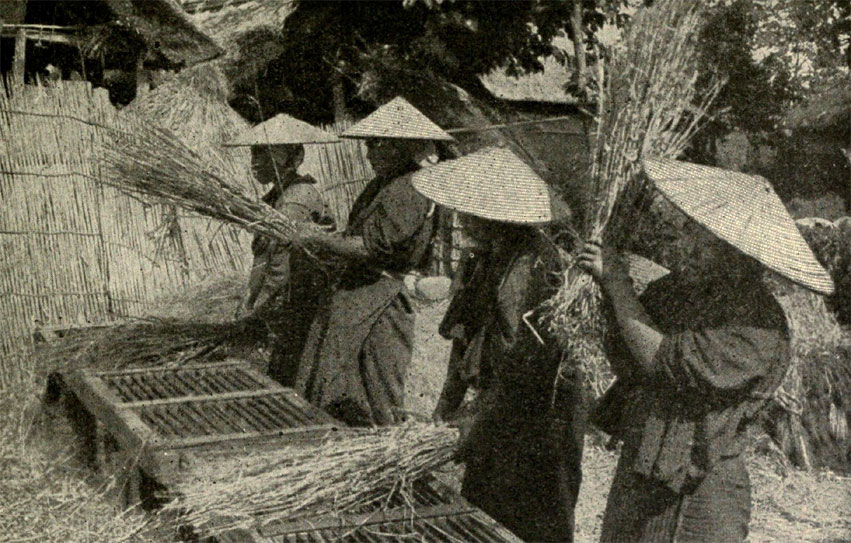 |
THE BUSY INTERIOR OF A FLOURISHING SILK FACTORY IN JAPAN THE STRIKING PROGRESS OF INDUSTRY IN MODERN JAPAN |
 |
JAPAN'S ENTRY INTO THE RANKS OF GREAT POWERS: HER GREATEST MILITARY ACHIEVEMENT, THE TAKING OF PORT ARTHUR |
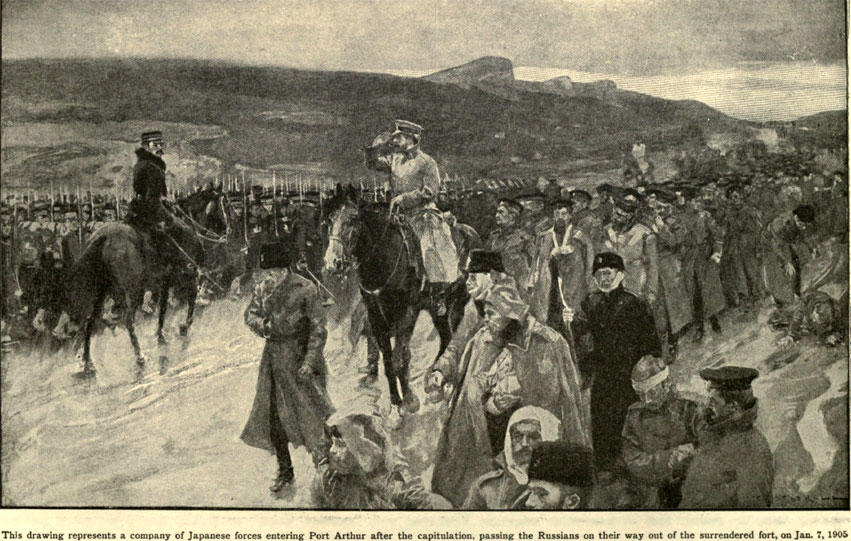 |

